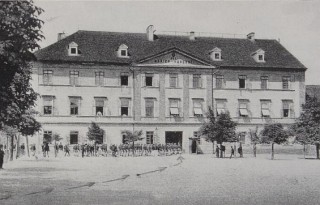
Mariánská kasárna in CB (Budweis). Until 1 June 1915 it was the home of the Good Soldier Švejk's Infanterieregiment Nr. 91. In 1915 Jaroslav Hašek also served with the regiment in these barracks.
The novel The Good Soldier Švejk refers to a number of institutions and firms, public as well as private. On these pages they were until 15 September 2013 categorised as 'Places'. This only partly makes sense as this type of entity can not always be associated with fixed geographical points, in the way that for instance cities, mountains and rivers can. This new page contains military and civilian institutions (including army units, regiments etc.), organisations, hotels, public houses, newspapers and magazines.
The line between this page and "Places" is blurred, churches do for instance rarely change location, but are still included here. Therefore Prague and Vienna will still be found in the "Places" database, because these have constant coordinates. On the other hand institutions may change location: Odvodní komise and Bendlovka are not unequivocal geographical terms so they will from now on appear on this page.
The names are colour coded according to their role in the plot, illustrated by these examples: U kalicha as a location where the plot takes place, k.u.k. Kriegsministerium mentioned in the narrative, Pražské úřední listy as part of a dialogue, and Stoletá kavárna, mentioned in an anecdote.
 Institutions index of institutions, taverns, military units, societies, periodicals ... (288)
Show all
Institutions index of institutions, taverns, military units, societies, periodicals ... (288)
Show all I. In the rear
I. In the rear  14. Švejk as military servant to senior lieutenant Lukáš (14)
14. Švejk as military servant to senior lieutenant Lukáš (14) II. At the front
II. At the front  1. Švejk's mishaps on the train (15)
1. Švejk's mishaps on the train (15) 2. Švejk's budějovická anabasis (38)
2. Švejk's budějovická anabasis (38) 3. Švejk's happenings in Királyhida (44)
3. Švejk's happenings in Királyhida (44) 4. New afflictions (26)
4. New afflictions (26)



|
II. At the front |
 | |
3. Švejk's happenings in Királyhida | |||
 | Lada |  | ||||
| Praha II./1733, Křemencová ul. 13 | ||||||
| ||||||
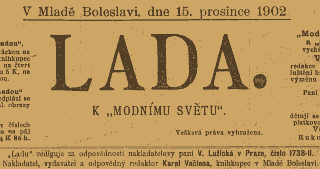
,15.12.1902

, 1910
Lada is briefly mentioned in Švejk's anecdote about negro Kristian. A female teacher wrote poems about shepherds and streams in the forest and published them in Lada. She also fornicated with an Abyssinian king and gave birth to the mentioned Kristian.
Background
Lada was a women's magazine that was published by Karel Vačlena in Mladá Boleslav with Věnceslava Lužická as its Prague-based editor[a]. It was published from 1889 to 1944 and a like-named magazine also appeared from 1861 to 1866. Whether there was a connection between the two is not known but in any case, Švejk definitely referred to the newer publication. In 1910 the magazine was published twice a month.
The magazine did print poems (at times even on the front page) but anything about shepherds and streams in the forest has not been found so far. At present (December 2021), only the year 1902 is publicly available.
Quote(s) from the novel
[II.3] Do toho se zamilovala jedna učitelka, která psala básničky do ,Lady’ vo pastejřích a potůčku v lese, šla s ním do hotelu a smilnila s ním. jak se říká v písmu svatým, a náramně se divila, že se jí narodil chlapeček úplně bílej.
Literature
| a | Adresář královského hlavního města Prahy a obcí sousedních | 1910 |
 | Kateřinky |  | ||||
| Praha II./468, Kateřinská ul. 30 | ||||||
| ||||||
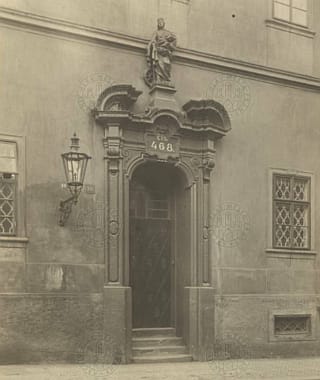
15.5.1906 • Pohled na vstupní portál domu čp. 468 v Kateřinské ulici na Novém Městě.
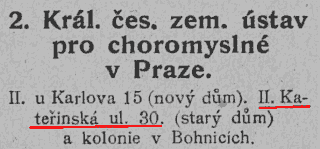
Kateřinky is mentioned in Švejk's story about negro Kristian. His mother was taken admitted to this asylum when she discovered that the dark skin of her son indeed was real.
It almost certainly the very institution where Švejk himself spent some time before the outbreak of war. See blázinec.
Background
Kateřinky was the colloquial name of a hospital for the mentally ill in Nové město. The official name was Královský český zemský ústav pro choromyslné v Praze, established in 1822[a]. It had subsidiaries at Na Slupi and Bohnice. These institutions still exist (2021).
Hašek at Kateřinky
Here Jaroslav Hašek spent some time in February 1911 after an apparent suicide attempt, where he tried to jump from Karlův most. Shortly after he was released he printed a story that in part seems related to this episode[b]. Nor is there any doubt that Hašek's stay here inspired the chapter on Švejk at blázinec.
It has been claimed that this suicide attempt was staged but the fact is that he was hospitalised on 9 February and left on the 27. Hašek actually asked to be allowed to stay at the asylum because he wanted to get rid of his alcohol habits. According to Radko Pytlík the incident was triggered by a domestic quarrel[c].
Quote(s) from the novel
[II.3] Tak se z toho pomátla, začala se ptát v časopisech o radu, co je proti mouřenínům, a vodvezli ji do Kateřinek a mouřenínka dali do sirotčince, kde z něho měli náramnou legraci.
Literature
- Řivnáčův Průvodce po Praze a okolí, ,1881 [a]
- Psychiatrická záhada, Jaroslav Hašek,24.4.1911 [b]
- Toulavé house, ,1971 [c]
- Zemské ústavy pro choromyslné v Čechách, ,1926
- Der Dichter des "Švejk" in Irrenhaus, ,10.9.1929
| a | Řivnáčův Průvodce po Praze a okolí | 1881 | |
| b | Psychiatrická záhada | Jaroslav Hašek | 24.4.1911 |
| c | Toulavé house | 1971 |
 | Varieté |  | |||
| Karlín/283, Palackého tř. 6 | |||||
| |||||
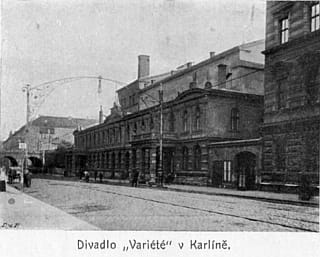
Praha moderní i historická ve 250 obrazech, ,1907
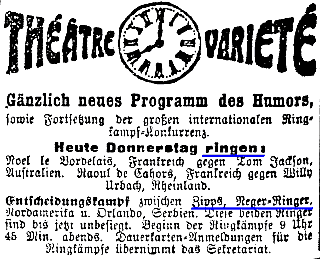
,18.4.1912

Průvodčí cizinců a jiné satiry z cest i domova, ,1913
Varieté is mentioned in Švejk's story about negro Kristian. Here it regards a case wehere a white lady unexpectedly gives birth to a black child. If this lady had been visiting Varieté on her own to watch a some negro in a game of wrestling one would certainly think certain thoughts.
Background
Varieté was the name of a theatre in Karlín that was opened in 1881. It is this one of the oldest theatres in Prague and is still operating, albeit with the name Karlín Music Theatre[a]. According to the address book from 1907 the official name was Théâtre Variété. Newspaper adverts reveal that they also arranged wrestling games[b].
Wrestling at Varieté
The thematic chain of Varieté-wrestling-negro is a re-use from two of Hašek's pre-war stories. Here the black wrestler is clearly identified as a North American champion with the surname Zipps[c][d]. This makes is straightforward to trace the inspiration for this sequence of The Good Soldier Švejk. In April 1912 Varieté arranged a major wrestling tournament and amongst the participants was the black wrestler Zipps [b].
Jak jsem přemohl černošského obra Zippse ze Severní Ameriky
Docílil snad vynálezce rádia Curie tak krásného výsledku, že německý zápasník Urbach položil se na lopatky za 5 minut? A dovolte ještě jednu otázku. Dostal někdy Svatopluk Čech do takového krásného mostu Skota Rankina, aby z toho mostu přehodil si onoho siláka přes rameno na zem, jako to udělal Zipps, ten šampión Severní Ameriky, o kterém mluvila celá Praha, když vystupoval v řeckořímských zápasech ve Varieté?
Machar si to velmi popletl s tou antickou kulturou. Nejsou to nějaké staré hrníčky, vykopané v Aténách a v Římě, ani básně starých Řeků a Římanů, synové Hélioví zanechali nám jiný, nehynoucí pomník, řeckořímské zápasy ve Varieté, kde z chumelenice hladkých těl vztyčuje se postava slavného zápasníka černocha Zippse, kterému jsem šlápl na kuří oko v Brejškově plzeňské restauraci.
Jaroslav Hašek, Dobrá kopa, 3.5.1912.
Quote(s) from the novel
[II.3] Ale najednou v nějakém kolenu že se vobjeví černoch. Představte si ten malér. Vy se voženíte s nějakou slečnou. Potvora je úplně bílá, a najednou vám porodí černocha. A jestli před devíti měsíci se šla podívat bez vás do Varieté na atletické zápasy, kde vystupoval nějakej černoch, tu myslím, že by vám to přeci jen trochu vrtalo hlavou.“
Literature
- Historie divadla, [a]
- Théâtre Variété, ,18.4.1912 [b]
- Jak jsem přemohl černošského obra Zippse ze Severní Ameriky, Jaroslav Hašek,3.5.1912 [c]
- Průvodčí cizinců a jiné satiry z cest i domova, ,1913 [d]
| a | Historie divadla | ||
| b | Théâtre Variété | 18.4.1912 | |
| c | Jak jsem přemohl černošského obra Zippse ze Severní Ameriky | Jaroslav Hašek | 3.5.1912 |
| d | Průvodčí cizinců a jiné satiry z cest i domova | 1913 |
 | Pražské ledárny |  | |||
| Praha VII./862, Ostrov Velké Benátky - | |||||
| |||||
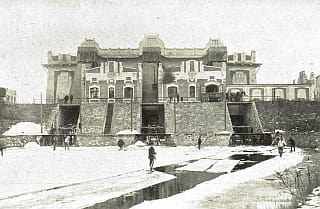
Branické ledárny s ledovým zálivem
,1.1.1913

,14.3.1912
Pražské ledárny is mentioned in the conversation between Švejk and Einjährigfreiwilliger Marek on the way from Mariánská kasárna to Budějovické nádraží. It regards Franz Joseph Land and deliveries to Prague's ice works.
Background
Pražské ledárny was a company that delivered ice to breweries, restaurants, hospitals, dairies, butchers and other enterprises that used ice for cooling purposes. To judge by newspaper adverts it was established in 1884[a] and was privately owned. Owner in 1892 was Ivan Čížek and in 1896 Bernard Lüftschitz is listed as owner. In both cases there were also other ownersdet. The ice works were from located at Štvanice island (also called Velké Benátky).
In 1898 the city had plans to build a new ice plant that was better able to satisfy the growing demand. The plans didnẗ materialise but in 1901 Lüftschitz sold his ice works[c] to a newly formed co-operative company named Společenské ledárny v Praze. It was owned by its customers and in 1908 they had 234 members[d], a number that by 1912 had grown to 299.
In Dolní Krč existed a rival enterprise owned by Tomáš Welz. In 1913 they two companies merged.
New plant
From 1909 to 1911 a new and bigger plant was constructed at Braník south of the city. The construction cost was however so high that the firm went bankrupt, but convertion to a limited company and investment of fresh capital saved it. The new company was registered in 1913 under the name Akciové ledárny v Praze[e]. In 1914 it reported a profit.
The company operated until 1954 and the building is still intact but in need of repair (2021). It was since 1964 been under heritage protection.
Quote(s) from the novel
[II.3] Podle statistiky je tam samý led a vyváží se odtud na ledoborcích patřících pražským ledárnám. Tento ledový průmysl je i cizinci neobyčejně ceněn a vážen, poněvadž je to podnik výnosný, ale nebezpečný.
Literature
- Adresář královského hlavního města Prahy a obcí sousedních, ,1892
- Adresář královského hlavního města Prahy a obcí sousedních, ,1896
- Adresář královského hlavního města Prahy a obcí sousedních, ,1910
- Sägespäne, ,12.1.1884 [a]
- Prager Eiswerke, ,12.7.1884
- Prager Eiswerke, ,1.11.1898 [b]
- Genoßenschafs-Eiswerke in Prag, ,23.1.1901 [c]
- Jak se děla led a v Praze na Vltavě zvláště, ,1.2.1907
- Společenské ledárny v Praze, ,29.2.1908 [d]
- Die Eiswerke in Branik, ,19.2.1911
- Společenské ledárny v Praze akciovou společností, ,22.2.1912
- Prazšké společenské ledárny, ,31.3.1912
- Konkurs, ,9.7.1912
- Ledárny, ,7.9.1912
- (Die Eiswerke in Branik), ,13.3.1913
- Nové české podniky, ,5.7.1913 [e]
| a | Sägespäne | 12.1.1884 | |
| b | Prager Eiswerke | 1.11.1898 | |
| c | Genoßenschafs-Eiswerke in Prag | 23.1.1901 | |
| d | Společenské ledárny v Praze | 29.2.1908 | |
| e | Nové české podniky | 5.7.1913 |
 | K.k. Handelsministerium |  | |||
| Wien I., Postgasse 8 | |||||
| |||||
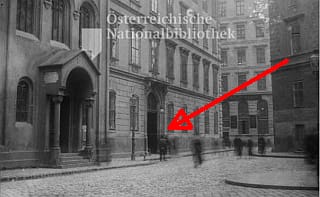
Nr. 10 (St. Barbara) und Nr. 8 (Handelsministerium).
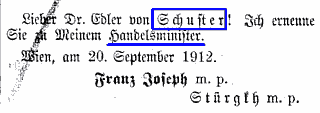
,21.9.1912
K.k. Handelsministerium is mentioned in the conversation between Švejk and Einjährigfreiwilliger Marek on the way from Mariánská kasárna til Budějovické nádraží. The theme is supply of ice from Franz Joseph Land.
Background
K.k. Handelsministerium (R.I. Trade Ministry) was the ministry of trade of Cisleithania and one of nine ministeries[1] in the Austrian part of the Dual Monarchy. It was housed in Postgasse in the centre of Vienna. Secretary of trade from 20 September 1912 was Rudolf Schuster Edler von Bonott[a], an office he held until 30 November 1915[b].
The ministry of trade was one of the heavyweights of its kind in Cisleithania. Their areas of resposibility including trade, industry, the merchant fleet, mail, telephone, telegraph, customs, and from 1908 worker's welfare and social security[c].
1. Ministerium des/für Innern, Justiz, Unterricht, Finanz, Handel, öffentliche Arbeiten, Eisenbahn, Ackerbau, Landesverteidigung.
Quote(s) from the novel
[II.3] Nicméně úpravou klimatických poměrů, na které má velký zájem ministerstvo obchodu i zahraniční ministerstvo, je naděje, že budou náležitě využitkovány velké plochy ledovců.
Also written:R.I. Trade MinistryenC.k. ministerstvo obchoducz
Literature
- Amtlicher Teil, ,21.9.1912 [a]
- Amtlicher Teil, ,1.12.1915 [b]
- Grégrova příručka, ,1912 [c]
| a | Amtlicher Teil | 21.9.1912 | |
| b | Amtlicher Teil | 1.12.1915 | |
| c | Grégrova příručka | 1912 |
 | K.u.k. Außenministerium |  | |||
| Wien I., Ballhausplatz 2 | |||||
| |||||
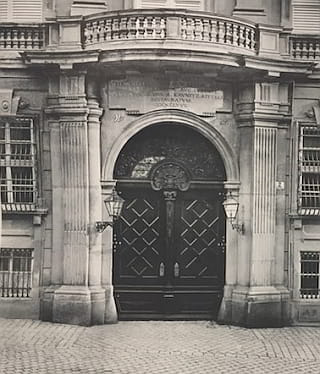
Ballhausplatz 2

,19.2.1912
K.u.k. Außenministerium is mentioned in the conversation between Švejk and Einjährigfreiwilliger Marek on the way from Mariánská kasárna til Budějovické nádraží. The theme is supply of ice from Franz Joseph Land.
Background
K.u.k. Außenministerium (I. and R. Foreign Ministry) (officilally k.u.k. Ministerium des kaiserlichen und königlichen Hauses und des Äußern) was the ministry of foreign affairs for the Dual Monarchy, one of thre three common ministeries (the others were k.u.k. Kriegsministerium and k.u.k. Finanzministerium). It was housed at Ballhausplatz by Hofburg in the centre of Vienna.
Secretary of foreign affairs from february 1912 was Count Leopold Berchtold, an office he held until January 1915. Berchtold played the dominant role in the decision-making process in Vienna that led to war in the summer of 1914[a], and it was he who drafted the 10 point ultimatum to Serbia. Berchtold was succeeded by István Burián.
Not only foreign affairs
As is evident from the full title of the ministry it was not only tasked with running foreign affairs in the classic sense (diplomacy, embassies, consulates, foreign policy etc.). It was even responsible for archives of the Imperial and Royal House (k.u.k. Haus, Hof und Staatsarchiv)[b].
Quote(s) from the novel
[II.3] Nicméně úpravou klimatických poměrů, na které má velký zájem ministerstvo obchodu i zahraniční ministerstvo, je naděje, že budou náležitě využitkovány velké plochy ledovců.
Also written:I. and R. Foreign MinistryenC. a k. zahraniční ministerstvocz
Literature
- Ministerium des Äußeren,
- Ballhausplatz, William D. Godsey [a]
- Grégrova příručka, ,1912 [b]
| a | Ballhausplatz | William D. Godsey | |
| b | Grégrova příručka | 1912 |
 | K.k. Unterrichtsministerium |  | |||
| Wien I., Minoritenplatz 5 | |||||
| |||||

Palais des Unterrichtsministeriums

,4.11.1911
K.k. Unterrichtsministerium is one of three ministries mentioned by Einjährigfreiwilliger Marek in the conversation between him, Švejk and the escort Korporal on the way from Mariánská kasárna til Budějovické nádraží. The theme is the supply of ice from Franz Joseph Land.
Background
K.k. Unterrichtsministerium (I.R. Education Ministry) (officilally k.k. Ministerium für Kultus und Unterricht) was the ministry of culture and education for Cisleithania. It was housed at Minoritenplatz in the centre of Vienna.
Secretary of Education from 4 November 1911 was Max Hussarek von Henlein[a], a position he held until 1917.
Responsibilities
The ministry was responsible for education (apart from academies for trade, industry and agriculture), the Evangelical Church (Protestant), art, memorials, museums, science academies, meteorological institutes and son on[b].
Quote(s) from the novel
[II.3] „Ministerstvo vyučování, pane kaprále, zbudovalo pro ně s velkým nákladem a obětmi, kdy zmrzlo pět stavitelů...“ „Zedníci se zachránili,“ přerušil ho Švejk, „poněvadž se vohřáli vod zapálený fajfky.“
Also written:I.R. Education MinistryenC.k. ministerstvo vyučovánícz
Literature
- Unterrichtsministerium,
- Inland, ,4.11.1911 [a]
- Grégrova příručka, ,1912 [b]
| a | Inland | 4.11.1911 | |
| b | Grégrova příručka | 1912 |
 | Budějovický hotel (naproti nádraži) |  | |||
| |||||
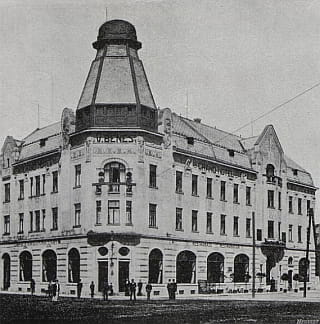
, 30.7.1909
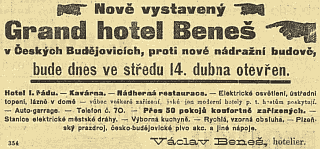
, 14.4.1909
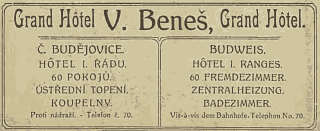
Budějovický hotel (naproti nádraži) (hotel opposite the station) is mentioned when the arrestees Švejk and Einjährigfreiwilliger Marek are escorted to Bud-Nad during the regiment's transfer from Budějovice to Bruck an der Leitha - Királyhida. From the windows of a hotel opposite the station, some ladies waved with handkerchiefs and shouted "Heil!".
Background
Budějovický hotel (naproti nádraži) refers to one of several hotels that were located around the railway station in Budějovice. Opposite the new station were situated Hotel Grand and Hotel Imperial, whereas opposite the old one were Hotel Bahnhof and Hotel Kaiser von Österreich[a]. Following the most direct route from Mariánská kasárna to Budějovické nádraží (the new station) the soldiers would first have arrived by Imperial but this hotel existed from 1924[b] so Grand remains as the obvious alternative. Nor should the two hotels by the old station be ruled out, but these were located further to the south so it is less likely that Hašek had one of these in mind.
Grand Hotel Beneš
This hotel opened in 1909 and the owner was Václav Beneš (1860-), an experienced hotel owner who also had managed Hotel U třech kohoutů and Hotel Slunce på Budějovické náměstí [c]. Grand was the most modern hotel in the city, equipped with electric lighting, central heating and parking space for automobiles, which was very rare at the time.
Prominent guests often stayed here and one example is Feldmarschall-Leutnant Simon Schwerdtner (see Generalmajor von Schwarzburg) who slept at Grand when he inspected the garrison in Budějovice in April 1915[d]. Other guests were Archduke Joseph Ferdinand and Erzherzog Leopold Salvator from the house of Habsburg, noblemen Baron Alfred Rotschild and Duke Ernst August von Cumberland, moreover military notabilities like Andeas Pitlik, Wenzel Wurm and (Arthur Gieslingen).
In 1918 Beneš sold the hotel[e], in 1949 was nationalised and renamed Hotel Vltava, until it in 1989 again became Grand. Today (2022) there is still a hotel and restaurant operating in the building, but according to the reviews at Google the standard is poor.
Quote(s) from the novel
[II.2] Byla to pořádná manifestace. Z hotelu naproti nádraží z oken mávaly nějaké dámy kapesníky a křičely „Heil!“ Do „nazdar“ mísilo se „heil“ i ze špalíru a nějakému nadšenci, který použil té příležitosti, aby vykřikl: „Nieder mit den Serben“, podrazili nohy a trochu po něm šlapali v umělé tlačenici.
Credit: Jan Schinko
Literature
- Hotel Grand,
- Hotely, [a]
- "Imperial" - bar a kavárna, ,31.10.1924 [b]
- Přezvetí hotelu, ,2.11.1908
- Grand Hotel "Beneš" v Čes. Budějovicích, ,20.8.1909
- Inspizierung, ,16.4.1915 [d]
- Hotelkauf, ,21.6.1918 [e]
- Hotelu Internacional se nedařilo, skončil po dvanácti letech, ,5.5.2016
- Původní majitel Grandu načasoval stavbu šikovně, ,1.6.2017 [c]
| a | Hotely | ||
| b | "Imperial" - bar a kavárna | 31.10.1924 | |
| c | Původní majitel Grandu načasoval stavbu šikovně | 1.6.2017 | |
| d | Inspizierung | 16.4.1915 | |
| e | Hotelkauf | 21.6.1918 |
 | Kavalleriedivision Nr. 7 |  | ||||
| Kraków | ||||||
| ||||||

1914
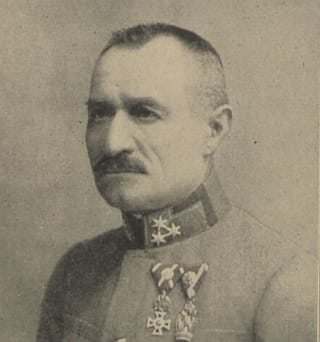
GdK. Ignaz Edler von Korda
Unteilbar und Untrennbar, , 1917
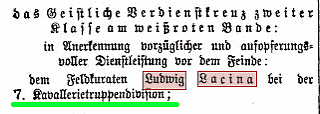
,25.12.1915
Kavalleriedivision Nr. 7 was according to the text of The Good Soldier Švejk the unit where Feldoberkurat Lacina served.
Background
Kavalleriedivision Nr. 7 was a cavalry division headquartered in Kraków, reporting to the 1. Korpskommando. The four regiments of the division were scattered across a large area: Dragonerregiment Nr. 10 (Kraków), Ulanenregiment Nr. 2 (Tarnów), Dragonerregiment Nr. 12 (Olmütz) and Ulanenregiment Nr. 3 (Gródek Jagielloński). The division's commander in 1914 was Feldmarschall-Leutnant Ignaz von Korda (1858-1918)[a]. The exact address of the divisonal HQ is not known.
Ludvík Lacina
The direct reason why the division is mentioned in The Good Soldier Švejk is that Ludvík Lacina, the model for Feldoberkurat Lacina was actually assigned to this unit from January 1913 to August 1916. That Jaroslav Hašek was aware of these details indicates that he knew Lacina personally.
Cavalry divisions
At the outbreak of war k.u.k. Heer contained eight cavalry divisions, numbered 1 to 10 where the numbers 5 and 9 were unused. The divisions were organised in one to three brigades. These usually consisted of to Ulan- Hussar- or Dragon-regiments. The cavalry brigades in Bohemia (Prague and Pardubice) were not assigned to any particular division[a].
During the war
From 6 August 1914 the division operated on Russian soil in the area around Kielce, north of Krákow. From May 1915 in the offensive in Russian Poland and in the autumn they operated by the river Styr (Стир) east of Lutsk (Луцьк) in current Ukraine. At the turn of the year, they were stationed by Brody. During the Brussilov offensive (from 4 June 1916) it suffered disastrous losses and was no longer of value as a fighting unit. After reinforcement and recuperation, they were in November 1916 moved to the new front against Romania.
Quote(s) from the novel
[II.3] Tak vešli na nádraží a šli k určenému vojenskému vlaku, když málem by byla ostrostřelecká kapela, jejíž kapelník byl vážně popleten nečekanou manifestací, spustila „Zachovej nám, Hospodine“. Naštěstí v pravé chvíli objevil se v černém tvrdém klobouku vrchní polní kurát páter Lacina od 7. jízdecké divise a počal dělat pořádek.
[II.3] Pohlcoval mísy s omáčkami a knedlíky, rval jako kočkovitá šelma maso od kostí a dostal se v kuchyni nakonec na rum, kterého když se nalokal, až krkal, vrátil se k večírku na rozloučenou, kde se proslavil novým chlastem. Měl v tom bohaté zkušenosti a u 7. jízdecké divise dopláceli vždy důstojníci na něho.
[II.3] Dostal nyní nový záchvat velkodušnosti a tvrdil, že všem udělá dobře, jednoročnímu dobrovolníkovi že koupí čokoládu, mužům z eskorty rum, desátníka že dá přeložit do fotografického oddělení při štábu 7. jízdní divize, že všechny osvobodí a že na ně nikdy nezapomene.
Literature
- Schematismus für das k.u.k. Heer (s. 80), ,1914 [a]
| a | Schematismus für das k.u.k. Heer (s. 80) | 1914 |
 | 12. Kompanie |  | |||
| |||||
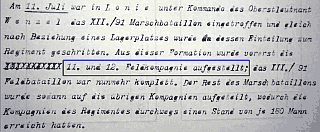
12. Feldkompanie reconstituted on 11.7.1915.
Das Infanterieregiment Nr. 91 am Vormarsch in Galizien,1927

Some names from 12. Feldkompanie. These soldiers were decorated on 18.8.1915.
© VÚA/VHA
12. Kompanie is mentioned on the train from Budějovice to Bruck-Királyhida. The author remarked that the company consisted of Germans from Krumlovsko and Kašperské Hory.
In [IV.3] it is revealed that they were commanded by some Kompaniekomandant Zimmermann.
Background
12. Kompanie is not unambiguously identifiable but the numbering indicates that it was meant one of the 16 field companies of Infanterieregiment Nr. 91. This assumption does however have a weakness. The plot at this stage takes place at the replacement battalion in Budějovice whereas the field companies had been fighting at the front since the start of the war. Thus one would assume that the company was an Ersatzkompanie or Marschkompanie. However, this is at odds with the fact that in 1915 these companies were never numbered as high as 12. The march battalions usually consisted of four companies and the reserve battalions rarely more than that.
This contradiction is rather a result of the author of The Good Soldier Švejk not bothering much about details like the numbering of military units and the logical connection between them. See also 11. Kompanie.
12. Feldkompanie
Throughout the novel Hašek consistently uses the numbering of field companies when he refers to "march companies" or simply "companies". This connection is particulalrly evident with the fictional "11th march company" where not only the number is borrowed from the corresponding field company but also the people in the command hierarchy (Rudolf Lukas, Čeněk Sagner). Thus there is every reason to assume that the same applies to 12. Kompanie. This company was one of four in III. Feldbataillon, the battalion that from 3 July 1915 was commanded by Sagner. The company commander from 11 July was Paul Kandl (1884-?), a reserve lieutenant from Prachatice[b] who propably arrived at the front with XII. Marschbataillon and surely was the commander of one of the battalion's four march companies. The 12th company was probably created directly from one of the four newly arrived march companies.
Jaroslav Kejla
Jaroslav Kejla who was taken prisoner together with Hašek on 24 September 1915 by Chorupan wrote about the four months he served with the company. As opposed to 11. Kompanie they were miserable catered for and parts of their rations were frequently stolen. The soldiers were dirty, exhausted, hungry, lice-ridden, and demoralised and during these four months, Kejla had a bath only once! He explained the difference between the 11th and the 12th company by the fact that the commander of the 11th company, Rudolf Lukas, was on friendly terms with battalion commander Čeněk Sagner and that his company, therefore, were better provided for[b].
Quote(s) from the novel
[II.3] Teprve řev z vagonů vzadu přerušil vypravování Švejkovo. 12. kumpanie, kde byli samí Němci od Krumlovska a Kašperských Hor, hulákala: Wann ich kumm, wann ich kumm, wann ich wieda, wieda kumm.
Literature
- Das Infanterieregiment Nr. 91 am Vormarsch in Galizien, ,1927 [a]
- Jak to bylo v bitvě u Chorupan kde se dal Jaroslav Hašek zajmout, ,1972 [b]
| a | Das Infanterieregiment Nr. 91 am Vormarsch in Galizien | 1927 | |
| b | Jak to bylo v bitvě u Chorupan kde se dal Jaroslav Hašek zajmout | 1972 |
 | Svět zvířat |  | ||||
| Smíchov/908, Bělohorská silnice | ||||||
| ||||||

No. 233: Probably the first issue that Jaroslav Hašek edited.
,15.2.1909
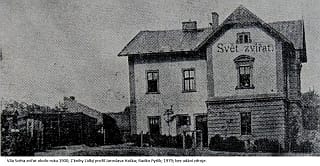
Víla Svět zvířat in 1903 or earlier.
Všecky druhy psů slovem i obrazem, ,1903
Svět zvířat is mentioned 11 times in The Good Soldier Švejk.
Svět zvířat (The Animal World) is the theme of the longest of all the numerous anecdotes in The Good Soldier Švejk, namely Einjährigfreiwilliger Marek's monologue in the prisoner's carriage on the way from Budějovice to Bruck-Királyhida. Here Marek relates in great detail about his experiences as an editor of this zoological magazine.
The story starts with Marek's friend Hájek being fired as editor by the magazine owner Fuchs after falling in love with his employer's daughter. Hájek was then tasked with finding a replacement and picked Marek who was subsequently interviewed for the post. He was questioned on his knowledge about animals, if he could cut and translate from foreign periodicals, translate from Brehm and his classic The Life of Animals, and how he envisaged the magazine's content going forward.
Marek answered that he in animals saw the transition from animal to human and that he also respected their wish to die as painlessly as possible before being eaten. He would introduce novelties like "Animals on Animals", "The Merry Animal's Corner", and "Movements among cattle". Fuchs was convinced enough to employ him and initially it proceeded smoothly. Still, after some time dark clouds began to gather above the head of the fresh editor...
The inventive Marek soon hit upon the idea that he ought to contribute more to zoology than the venerable Brehm had done in his "Life of Animals". The creatures from this book were after all well known and would thus be of little interest to the educated and inquisitive reader.
Out of thin air, he pulled creatures like the "sulphur-bellied whale", the "remote bat" from Iceland, Engineer Khún's Flea etc. This flea would eventually trip up Marek's career at the journal because it became the theme of a polemic between the newspapers Čech and Čas, where the latter swatted his flea by exposing the entire hoax. This incident, in addition to a heated debate with the editor of Selský obzor about the name of the jay eventually led to Marek being dismissed. The stress even caused Fuchs's premature death as he passed away three days after the final confrontation with his by-now-deposed editor.
Background

The magazine's origin, with an agenda of animal protection, hunting and purchase/sale of animals.
,1.10.1897



,15.2.1909
Svět zvířat (The Animal World) was an illustrated popular science magazine that specialised in animals and animal breeding that was established in Jičín by Jaroslav Podbodský (owner) and Václav Fuchs (publisher and chief editor). The first issue appeared on 1 September 1897 with a circulation of 10,000[j]. Already from the beginning, some well-known people wrote for the magazine, for instance the explorer Emil Holub.
In December 1898 Fuchs moved to a villa above the Klamovka gardens in Smíchov where he established the new editorial offices (by now he was by all evidence the sole proprietor). From 1901 onwards the magazine was issued twice a month and Fuchs established a kennel next to the villa (see Fuchsův psinec). In 1902 his wife Marie Fuchsová bought the villa for 22,400 crowns.
Chief editors were Václav Fuchs (1897-1911), Ladislav Hájek (1912-16, 1918-19), František Pober (1916-18,1920-22), Bohuslav Bayer (1917), and Karel Vika (1919)[t]. The best known co-editors were Karel Ladislav Kukla (1898-1906), Ladislav Hájek (1908-1909, 1910-1911) and, above all, Jaroslav Hašek (1909-1910, 1912-1913).
Václav Fuchs died in September 1911 and in 1912 the new owner Hájek relocated the editorial offices to the centre of Prague. The magazine continued to publish until 1922 when was renamed Život v přirodě, now with Svět zvířat as a supplement. An advert from 1925 reveals that the administration had moved back to the villa above Klamovka and was published weekly[2].
The annual subscription fee in 1910 was 10 crowns (13 crowns abroad), individual issues cost 50 hellers. The subscription prices had actually stayed the same since 1904! The magazine was published on the first and fifteenth every month, and publisher and chief editor was Václav Fuchs. The administration and editorial offices were located in the villa Svět zvířat above the Klamovka gardens in Smíchov and the journal was printed by Edvard Leschinger in Prague.
Staff

František Špirk was employed as an accountant and administrator in 1909 and also lived in the villa.
,1910
There exists no full overview of the staff during Hašek's time at Svět zvířat, apart from Václav Fuchs as owner, publisher and chief editor and Jaroslav Hašek as co-editor. If anyone else from the staff contributed to the journal is not known. One person that no doubt was associated with Fuchs' enterprise was Ladislav Čížek. As late as in 1957 a newspaper article provided more details, based on interviews with still living former staff. Apart from the mentioned Čížek Fuchs employed František Špirk as accountant and administratior and Josef Mikeš who dispatched parcels. A servant called Alois Ledecký also worked there[3].
Format and content
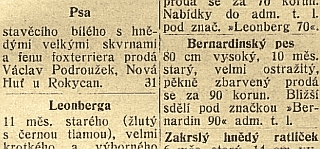
Classified adverts made up several pages.
,1.1.1910
In 1909 and 1910 each bi-weekly issue typically consisted of 24 pages. The first 2 and the last 9 mainly contained advertising and brief classified adverts. The remaining 13 pages carried animal-related material, written in a language comprehensible to everyman, interspersed with the odd advert. There is also a notable focus on animal welfare, particularly in the editorials and some of the in-depth articles.
In addition, the magazine published letters from readers, and entertainment in the shape of the column Veselý koutek (The Merry Corner). Further, each issue featured Svět rad (The World of Advice), Z celého světa (From Around the World). The World of Advice is probably based on Fuchs's book Všeobecný slovník rad pro každého (The General Dictionary of Advice for Everyone) (1906).
The Merry Corner predated Hašek's time at Svět zvířat with at least five years. ,15.1.1906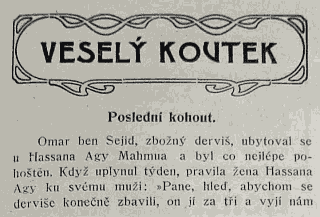
With nearly half the pages occupied by adverts, these were obviously an important source of income. Many adverts were for Fuchs' own journal and kennel, and even the enterprises of his brothers Diego and Evžen featured prominently. The classified minor adverts also played an important part. Under the headline Bursa zvířat (Animal Exchange) animals were advertised for purchase and sale, and many of the breeds mentioned in these adverts will strike a chord with readers of The Good Soldier Švejk.
Contributors
Fuchs, the owner and chief editor, wrote for the journal but his co-editor, be it Ladislav Hájek or Jaroslav Hašek, generally contributed more, at least to judge by the signed articles. Most entries were however unsigned and the shorter notices invariably so. Svět zvířat contained copious translated material, mostly of German origin, particularly from Brehms Tierleben (Brehm's Life of Animals).
The magazine contained many photos - mostly of animals but also of persons. Some of them feature people that the reader of The Good Soldier Švejk will recognize. Rittmeister Rotter, beekeeper Pazourek, Ladislav Hájek and Václav Fuchs are all pictured in the journal between 1909 and 1913. A considerable amount of the photos seem to have been cut from foreign magazines and books, again mostly German. In his article about in Strana mírného pokroku v mezích zákona, Hašek claims that virtually everything was translated from German, and the photos invariably so. One example of a pure translation is the article Modern whale hunting that originally appeared in Über Land und Meer. Here not only the text but also some photos were copied. In the period before Hašek became editor the magazine also contained material of Polish, English and French origin, often translated by Karel Ladislav Kukla (1863-1930). Translated from German were also stories by fiction writers Gustav Meyrink (1868-1932) and Alexander Roda Roda (1872-1945).
Still, Hašek's claim that almost everything was translated is a gross exaggeration. As editors both Hašek, Hájek and Karel Ladislav Kukla wrote copious original material, so did Mařenka Fuchsová-Poberová (daughter of Fuchs). Other Czech contributors were the explorers Emil Holub and Alberto Vojtěch Frič, the poets Gustav Roger Opočenský and Adolf Heyduk, the writer Pavla Moudrá and the police officer Theodor Rotter. All co-editors (Kukla, Hájek and Hašek) were productive during their respective periods at the journal. The regular column about beekeeping was also Czech, mostly written by Karel Pazourek.
Hašek succeeds Hájek as editor
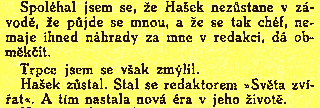
Hájek describes how Hašek betrayed him.
,1925
Early in 1908 the above-mentioned Hájek, one of Jaroslav Hašek's closest friends, was employed as editor of Svět zvířat. In the evening of the Vinohrady by-elections [s] (20 November 1908) he met Hašek in a pub, without a place to sleep and with wrecked shoes. Hájek offered his friend to stay with him in the villa above Klamovka. Hašek offered to help with the editorial work, he wanted to escape from the life he was currently living. Hašek wrote an item, was introduced to Fuchs, showed him what he had written and was offered a job, albeit with less pay than Hájek[a].
For some time the two friends worked together for Svět zvířat, but the situation was soon to change. Hájek, who was in love with the owner's daughter Žofie, felt that Fuchs pushed too hard to involve him in the family and in the business. Moreover, he was at odds with another employee. One day it boiled over, he had a row with his boss and handed in his resignation. He had hoped that Hašek would show solidarity and leave together with him but the "traitor" Hašek instead took over his job[a].
From 4 February 1909 until 28 July 1910 Hašek's registered domicile was Vila Svět zvířat. ,1851 - 1914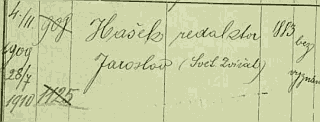
According to police registers Hašek lived in Vila Svět zvířat from 4 February 1909 until 28 July 1910[b]. Thereafter, he is registered at Smíchov No. 1125, below the Klamovka gardens, but within walking distance to the villa. Note that these are recorded dates and may not necessarily correspond to the actual dates he moved.
Hašek's first signed contribution. ,15.2.1909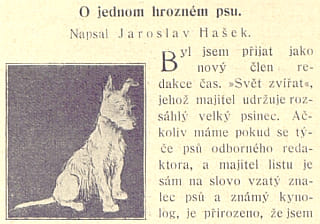
One would thus assume that the change of editors happened in late January or early February 1909 and indeed on 15 February 1909 Hašek's first signed contribution appeared. Here the new editor describes his first encounter with the magazine. Václav Fuchs asked him to write an expert article on Chinese Pinschers (dogs) and Hašek described how he felt the weight of not being up to the task.
There is however an indication of a contribution already on 15 January. In this issue, there is a notice about the hippopotamus: "the Negroes caress baby hippos by blowing strongly up their nostrils"[o]. Hašek himself later claimed this as his hoax in a story he wrote after he had left the magazine[e] and for once there are good reasons to believe him. Still, it is astonishing that he dared such mischief at such an early stage! Hašek probably contributed also at the end of 1908, but this volume is yet to be investigated.
Permanently employed
Hašek's engagement with Svět zvířat was only the second time in his life that he was permanently employed, and now he lasted much longer in the job than he did at Banka Slavia, probably around 20 months. Fuchs was initially satisfied with his new employee, paid him decently, and the allowance even included two litres of beer a day! This way of rewarding the thirsty editor was simply a ploy to keep him on a short leash[a].
Officially stamped love letters

Letter to Jarmila, 10 July 1909
Information about his life above Klamovka can be found first-hand in his letters to his beloved Jarmila Mayerová who he had been courting since 1906. During the summer of 1909, she stayed in Přerov and letters between the two from this period have been preserved. Several of them are written on paper with the Svět zvířat letterhead, and some of them are even stamped!
In July 1909 Hašek complained to Jarmila about being overworked because Fuchs had gone away for a month, didn't write for the magazine at all, and left his understudy in charge of the enterprise. In addition, Hašek was busy running Fuchs' kennel, and evidently, he enjoyed working with animals, particularly his chimpanzee friend Julča who features in the journal several times, including on pictures. Hašek later wrote the story "My dear friend Julča"[k]. What he doesn't mention in the love letters is that he from 29 July to 3 August spent time behind bars due to a brawl at Bendlovka during some wild New Year celebrations.
Feathers flying
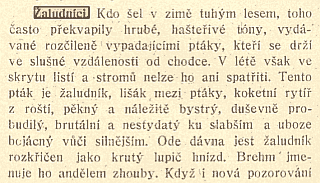
Hašek's mishap with the acorner.
,15.7.1909
During chief editor Fuchs's absence, his trusted understudy suffered a minor mishap, one that in a reshaped form found its way into The Good Soldier Švejk. On 15 July 1909 appeared in the Svět zvířat an item in a series of brief descriptions of animals[n]. This time it was the turn of the jay, and Hašek evidently translated these snippets from German, most probably from Brehm. In German the bird is called Eichelhäher (Garrulus glandarius), a name that indicates a connection to acorns (Eichel). This name stems from the fact that jays collect acorns and other nuts and store them as winter supplies. In Czech the word for acorn is žalud and Hašek translated Eichelhäher as žaludník whereas the correct term is sojka.
According to Radko Pytlík the editor of Selský obzor (Jos. M. Kadlčák) pointed out the error on a postcard to which Hašek responded impertinently. Kadlčák then complained in writing directly to Fuchs [k]. Hašek however stood his ground and published a response from a "reader" that also used the term "žaludník". Readers of The Good Soldier Švejk will recognise Einjährigfreiwilliger Marek in this story, but on this occasion, Hašek's ornithological mishap had no immediate consequence. Through The Good Soldier Švejk and Marek's story Hašek thus transformed his translation mistake into conscious mystification.
Married

Hašek telling Jarmila about the conditions at the journal. The owner was about to leave for a month and left his understudy to manage the entire enterprise, including the kennel.
,10.7.1909
Hašek's improved financial situation, permanent employment and tidier lifestyle finally convinced Hašek's future parents-in-law that he was worthy of their daughter's hand and would be able to live an orderly life. In a letter dated 9 August 1909, Josefa Mayerová consented to the young couple getting married and Jarmila returned from Přerov soon after. From then on the correspondence between them paused but in March 1910 Hašek in a letter to his fiancee apologised for not being able to meet her that day. The reason was that he had to go on a business trip to Prague with Fuchs and he also told her that his employer had promised him a salary increase as soon as he got married (180 crowns per month).
On 23 May 1910, the couple finally married and they went on a short honeymoon to Motol. In the beginning Hašek was a model husband but in the end couldn't help being himself and started to stray around the pubs again. Not only did the return to his unruly lifestyle cause his wife pain but his appearances in the office became increasingly irregular[a].
Calamity

Hašek trying desperately to save his job.
,1925
Fuchs's initial enthusiasm had cooled due to Hašek often being absent and he had also been alarmed by reports that entries of dubious veracity appeared in his magazine and that readers had started to complain. Ladislav Hájek also relates that Hašek openly boasted to his friends about his past and ongoing "discoveries"! The exasperated Fuchs decided to get rid of Hašek, drove to Poděbrady and threatened Hájek that he would not be allowed to see his beloved Žofie unless he returned to take charge of the journal. A confrontation with Hašek took place and the latter claimed that everything that was printed had been translated correctly. Allegedly the only liberty he had taken was to substitute the names of some professors with those of his friends! Hájek noted that Hašek begged for mercy and was allowed to stay on but after about three months he decided to leave, complaining about poor pay[a].
The return of Hájek
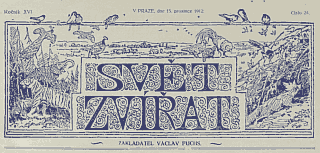
With Ladislav Hájek becoming chief editor and eventual owner, the office was moved to Prague, and a new header was introduced.
,15.12.1912
Hašek's last story appeared on 15 October 1910 and Hájek was in charge again by the same time[c]. Hašek's dismissal from the magazine must have been a harsh blow to the newly wed couple, the young husband losing a well-paid job. Hájek even expresses regret that he inadvertently deprived his married friend of his job. In November 1910 Jaroslav and Jarmila set up their own dog trade but the enterprise collapsed almost immediately.
Václav Fuchs suddenly died in the autumn of 1911 and the kennel was taken over by František Pober, his son-in-law. Pober renamed the kennel Canisport, a term he had used for his previous dog business at Vinohrady. The editorial offices of Svět zvířat were eventually relocated to Hájek's flat at Ferdinandova třida no. 13 (now Narodní) in the city centre. This seems to have happened in October 1912 because the magazine header from now on stated "in Prague" and no longer "in Prague above Klamovka". Hájek had succeeded Fuchs as chief editor and later became the owner.
The 1911-1912 interlude and a pre-historic flea
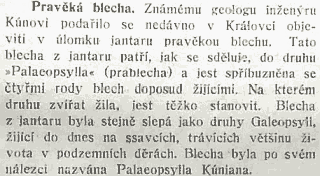
Hašek's notorious flea
,1.9.1911
Even though Hašek from late 1910 onwards was no longer employed at Svět zvířat there is evidence that he from time to time contributed. On 15 May 1912, a report from a dog exhibition was signed Jaroslav Hašek and some weeks later a humorous story signed by Wilde was published (1 July). Based on a text analysis, Radko Pytlík concludes that it was written by Hašek. This is no surprise as one would assume that Hašek still was on good terms with his friend Hájek who was now chief editor and owner.
On the other hand, the timing of the "discovery" of Engineer Khún's Flea, an unsigned notice in the column "From Around the World"[*], is very strange. It was printed around 10 months after Hašek left Svět zvířat. At this time Fuchs was still alive and functioning as chief editor with Ladislav Hájek as co-editor. Scholars have not identified any contributions by Hašek in 1911, but this entry proves the opposite. In addition to his famous flea, he may have provided other minor items. This subject needs further investigation and seems to have escaped Radko Pytlík and other experts. On the same date another entry that the editors of Malá zoologická zahrada assumed to be by Hašek was printed, but this story had already appeared in Plzenské listy and was surely not the work of the famous prankster. A plausible theory, suggested by Jaroslav Šerák, is that Hájek may have been in on the joke. Otherwise, it is difficult to explain how the flea could have found its way there.
Hašek pardoned

Christmas night in the forest, Hašek back as editor.
,15.12.1912
Towards the end of 1912, Hašek was again invited to stay with Ladislav Hájek who was now married to Fuchs' daughter Žofie. And like in November 1908 it was a "rescue operation" that brought him under the same roof as Hájek. And history repeated itself. Hašek duly promised to help with the editorial work and also declared that his little jokes from the past would not occur again! In the beginning, the undertaking proceeded smoothly and before Christmas Hašek wrote a run-of-the-mill story. But soon he started to drift around the pubs and neglected his duties at Svět zvířat [a]. On 15 May 1913, his last ever signed contribution was published. During his second period at the journal, there were no obvious hoaxes (apart from a few April Fool's jokes) and Hašek himself didn't write any short stories that refer to this shorter assignment at Svět zvířat.
Hašek's contributions

Some mysteries from prehistoric times.
,15.8.1910
It is impossible to know exactly how many stories and other items Hašek wrote for Svět zvířat. According to the most up to date bibliography[d] eighteen stories and articles are signed in full by Hašek and another nine with pseudonyms assumed to be his. The pseudonyms are: Frant. Winter, dr. Th. Zell, A.K, Dr. Vilém Stanko, Milka Langorvá, Jos. Pexider, Vladimír Mayer, Wilde, J.H.. Finally, eight stories are unsigned but believed to have been written by Hašek, based on text analysis.
Four items in the categories pseudonyms and unsigned are marked with "debatable authorship" and may be mere translations. This number can now (October 2024) be reduced to two as it has been revealed that dr. Th. Zell and Frant. Winter are not pseudonyms and that the corresponding items are translations from German. Theodor Zell was a well-known German zoologist and many of his articles were appeared in Svět zvířat in 1907 and 1908. Franz Winter wrote an article about modern whale hunting in Über Land und Meer that was translated and published in Svět zvířat.
In addition, there are numerous brief items that one assumes Hašek wrote or translated. The bulk of these were identified by Zdena Ančík, Milan Jankovič, and Radko Pytlík and are included in the compilation The Entertaining and Educational Corner of Jaroslav Hašek[q]. Hašek surely wrote more than 100 large and small entries but the exact number is impossible to ascertain.
Some curiosities from the kingdom of animals, here the hippo. This entry is one of only a handful of verified pranks by Hašek: The negros cuddle young hippos by blowing strongly up their nostrils. ,15.1.1909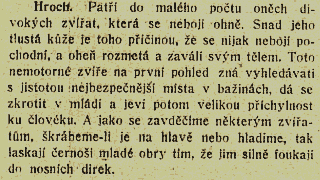
On 1 January 1909, the series Některé zajímavosti z říše zvířat, sestavené dle abecedního pořádku (Some curiosities from the kingdom of animals, compiled in alphabetical order) was introduced and this more or less coincides with Hašek's starting to contribute to the journal. One must assume that he wrote all these entries. The cycle featured in 15 issues of Svět zvířat, running until 15 August 1909 (with one gap). Altogether the series contains descriptions of 84 breeds, starting with the Amazon parrot and ending with the zebra.
The number of entries in each bi-weekly issue of Svět zvířat was as follows: 18, 4, 4, 4, 5, 5, 6, 5, 4, 7, 4, 2, 4, 3, 4, 0, 5. The series was introduced by aplomb in the first issue (18 animals) but the numbers soon dwindled to an average of 4 to 5. Nor was it always in alphabetical order and animals from the letter range O to S are missing altogether. The otter (vydra) and polecat (tchoř) even feature twice, albeit with differing descriptions.
In the summer of 1909 Fuchs went on holiday for at least a month so for a period Hašek surely produced more or less the entire content. This was also the time when his above-mentioned erroneous translation[n] of Eichelhäher (jay) allegedly caused a stir amongst ornithologists[k]. Sharks by Messina, mistakenly assumed to be one of Hašek's inventions. ,15.7.1909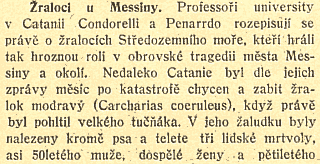
In the same issue appeared a sensational story called Sharks by Messina where inside a shark were found the bodies of three humans, a dog and a calf, and the bodies were well preserved and even dressed[m]. At first sight, the story bears the hallmarks of a grotesque invention and scholars have indeed assumed that it was. This is however not the case as several European and even American newspapers reported on the incident in early July 1909.
The reports are related to the earthquake disaster that hit Sicily and Calabria on 28 December 1908. The shark was caught by fishermen on 26 January 1909 and its stomach content was analysed by two professors from Catania University. They concluded that the victims probably were washed into the sea by the resulting tsunami and subsequently devoured by the animal[l]. The grisly story was recently mentioned in National Geographic[p]. The news as presented in Svět zvířat however makes it appear more grotesque than it actually was, giving the impression that inside the shark were found fully dressed bodies and not merely body remnants and rags.
Hašek wanting to buy a young wolf! ,15.3.1910
That Svět zvířat printed the story is probably more a testimony to Hašek's tendency towards the bizarre and sensational rather than being an example of a hoax. Similarly, many of his stories that are believed to be mystification may not be - rather resulting from Hašek's preferences when selecting material for publishing.
Hašek may have translated numerous such stories and twisted them slightly but verifying them is still a work in progress. The scholars who prepared the excellent "Entertaining and Education Corner of Jaroslav Hašek"[q] for obvious reasons didn't have the capacity nor the means to carry out such detailed investigations across all the foreign journals that may have carried the original news.
Hašek also "contributed" to Svět zvířat in an unexpected way. On 3-4 occations he advertised in the journal, wanting to buy animals. In one case he advertised, wanting to buy a young wolf. This suggests that he was already trading in animals, a prelude to his Kynological Institute? But by all accounts he wasn't interested in werewolves, other than as vehicles for his mystifications!
Josef Lada the poet. ,15.7.1910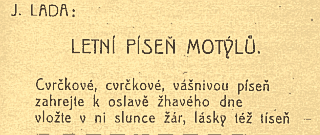
Amusing extras are the items that Hašek attributed to his friends. Both Opočenský and Josef Lada provided "signed poems" and Lada was even presented as a "translator of Hungarian" (Opočenský's poems may have been real). The story of Engineer Khún's Flea is in the same category. Here Hašek simply translated a story from German and swapped the name Klebs with that of his friend Kún!
Although the reading public automatically thinks of hoaxes when the words Svět zvířat and Hašek are mentioned together, it should not be forgotten that Hašek generally wrote entirely solid articles or humorous stories. These often revealed his impressive general knowledge, at times interspersed with non-zoological themes that we know from The Good Soldier Švejk (e.g. Xenophon, Lombroso). His affection for animals also shines through!
Photomontages and April Fools

Chief editor Ladislav Hájek wrestling with a tiger.
,1.4.1913
Professor Jindřich Toman points to a lesser-known feature of Svět zvířat: the photomontages[x]. Unsurprisingly these often appeared on the first of April. On 1 April 1911, the journal printed a photo that showed animals from the Hagenbeck Circus parading at Na Příkopě and one year later a picture of a giant rabbit on the South Pole appeared. Both these jokes were however published during a period when Hašek didn't work for Svět zvířat. In both cases the photo montages was so large that the chief editor (Václav Fuchs and Ladislav Hájek respectively) would have known about them.
On 1 April 1913, Svět zvířat printed a photo that shows Ladislav Hájek wrestling with a tiger and this one was surely the work of Hašek. The photo was accompanied by an amusing text, and in the same issue some incredible information about the rhinosaurus and a deformed carp was published. In the next issue Svět zvířat refuted it's own April Fool's jokes and made fun of those who had not noticed that it was 1 April! It was also announced that Právo lidu had snatched at the bait and that some people had even ordered tigers!
One year later a photo of the Vltava being flooded with muskrats appeared but by now Hašek had again left the magazine. Václav Menger picked up the news about this picture and dubiously claimed it was a joke by Hašek. Menger probably wasn't aware of the Hašek - Svět zvířat timeline and evidently didn't read the magazine, claiming the photo was of the Vltava by Vyšehrad (the scene is the Vltava by Národní divadlo). Cecil Parrott later translated part of Menger's tale (more on Parrott later).
In general, the use of photomontages was widespread in Svět zvířat and they actually seem less frequent (at least less obvious) during Hašek's two periods at the journal. Still, even today, some literary scholars interpret these April Fool's Day jokes as hoaxes by Hašek, neither taking his spells as editor nor the date 1 April into account[w].
Compilations
There exist many collections of Hašek's short stories, published in book form after the author's death. The first of these was The Collected Writings of Jaroslav Hašek (1926), a series of softback instalments that were not thematically arranged. Thus items from Svět zvířat appear in several of those but without bibliographical references.
Malá zoologická zahrada
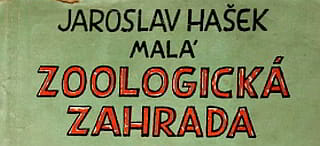
,1950
The first scholar to seriously investigate Hašek and his endeavours in Svět zvířat was Břetislav Hůla. In 1950 the book Malá zoologická zahrada (The Small Zoological Garden)[r] was published with Zdena Ančík listed as editor although Hůla no doubt did the groundwork. Most of this book is made up of Hašek's stories from various publications but it also contains 17 brief articles that the editor(s) assumed that Hašek wrote. Amongst those 17 items very few were actually written by Hašek...
Zábavný a poučný koutek Jaroslav Haška
Only as late as in 1973, after two decades of research, did a more convincing study of Hašek and his activities at Svět zvířat appear. The book is part of the series Spisy Jaroslava Haška (The Writings of Jaroslav Hašek) and is called The Entertaining and Educational Corner of Jaroslav Hašek[q]. It provides unique insight and importantly: this compilation contains literature references. It also has some material from České slovo and Svět, but most of the entries are from Svět zvířat.
Particularly illuminating is the epilogue by Radko Pytlík. Here the distinguished Hašek-expert, without stating it directly, exposes most of the myths surrounding Hašek and his career at the zoological journal. Importantly, Pytlík also emphasises that Hašek often reused motifs from Svět zvířat and other periodicals when he wrote The Good Soldier Švejk.
O Haškových pověstných mystifikacích jsme doposud věděli jen z
jeho pozdějšího humorného vyprávění, zejména z příslušných kapitol Dějin
strany mírného pokroku, z črty V přírodovědeckém časopise a z vyprávění
jednoročního dobrovolníka Marka ve Švejkovi. Podle shod, jež se nám nyní
po podrobném průzkumu časopisu podařilo objevit, zjišťujeme, že jsou v
pozdějším vyprávění vesměs přehnány a přetvořeny.
Radko Pytlík, 1973
The Animal World reflected in Švejk
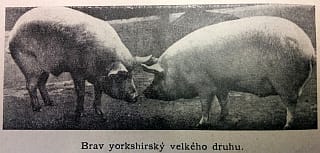
Many themes from the animal journal found their way into The Good Soldier Švejk
,1.7.1910
Although six of the seven species that Einjährigfreiwilliger Marek "invented" have no direct parallels in the columns of Svět zvířat, his story on the troop transport train from Budějovice to Bruck includes many themes that are related to Hašek's experiences as editor of the journal. Marek's version of how he succeeded Hájek is partly authentic and he mentions both the journal's owner Fuchs and his daughter (who Hájek indeed was in love with and later married). Engineer Khún's Flea and the follow-up in the columns of Čech and Čas is also a point where The Good Soldier Švejk and Svět zvířat overlap, although not in the way that Marek describes. Already mentioned is Marek's misnaming of the jay (sojka).
Motifs from other parts of The Good Soldier Švejk can also can traced back to Svět zvířat. One example is the story about Rittmeister Rotter and his police dogs, a tale that appears twice in the novel. Rotter contributed to the journal and at least twice it printed photos of him. He also bought dogs from Psinec nad Klamovkou. Another person that Hašek would have known from his time above Klamovka was beekeeper Pazourek who wrote in virtually every issue and also appears on several photos. The reader will also recognise numerous dog breeds, one example being the Leonberger. Further animals appear both in the journal and in The Good Soldier Švejk: Harz (canary), Engadin and Saanen (goats), Yorkshire (pig), Wyandotte (chicken), Angora (cat) etc. Another intersecting point is some dog exhibition in Berlin (see Berliner Stallpinscherausstellung ).
Mr. Jaroš from Králupy is another common theme. This pump manufacturer advertised in Svět zvířat and is also mentioned in a minor notice.
Marek's Seven Wonders of The Animal World
Seven animal species were "discovered" by Einjährigfreiwilliger Marek during the time he edited Svět zvířat, summarised in the table below. The English names and Marek's words are from Zenny Sadlon's translation (2009). The names used by Cecil Parrott (1973) differ slightly and Paul Selver (1930) left Marek's experiences at the journal out of this translation altogether.
| Czech | English | Marek | In Svět zvířat |
|---|---|---|---|
| velryba sírobřichá | sulphur-bellied whale | this new whale species of mine had the size of a cod fish and was equipped with a bladder filled with formic acid... | On 1 June 1909 the editorial Modern whale-hunting was published, signed Frant. Winter. Here the sulphur-bellied whale is mentioned and but is revealed as another word for the blue whale. The article is translated from German, most probably by Hašek. |
| blahník prohnaný | blisser-the-artful | a mammal from the kangaroo family | No obvious connection. |
| vůl jedlý | ox-the-edible | archetype of the cow | No obvious connection. |
| nálevník sepiový | sepian infusorian | which I characterized as a type of sewer rat | Infusoria are microorganisms living in freshwater. They are mentioned in Svět zvířat (e.g. 1 March 1912) but not at the time when Hašek edited the magazine. The word sepiový also appears but not in a context that can be linked to the description in The Good Soldier Švejk. |
| netopýr vzdálený | bat-the-remote | a bat from the island of Iceland | Bats are mentioned many times during the time Hašek edited Svět zvířat. Interesting is a minor item about bats, dated 1 February 1909. This was printed at the very beginning of Hašek's editorship. On the other hand: Iceland is not mentioned at all. |
| pačucha jelení dráždivá | deer-sniffer the irritable | domestic cat from the summit of the mount Kilimanjaro | No obvious connection. |
| blecha inženýra Khúna | engineer Khún’s flea | found in amber and blind “because it lived on an underground prehistoric mole, which was also blind | A story with many similarities was published on 1 September 1911, albeit at a time when Hašek no longer worked for Svět zvířat. The story was exposed as a hoax by Právo lidu on 19 August 1913, causing minor headlines in several newspapers. See Engineer Khún's Flea. |
Myths

The sulphur-bellied whale was real enough (big blue) but in a literary context Hašek changed its attributes drastically!
,1.6.1909
The entire story of Jaroslav Hašek's life is shrouded in legend and his period as editor of Svět zvířat is a prime example. Many of the more or less credible stories related to Hašek and The Animal World circulate even to this day (2024) and some have found their way into foreign-language books, academic papers, and websites (including the one you are currently looking at).
Most widespread is the claim that Hašek published stories about imaginary species, rumours that he himself may have set in motion already before his dismissal from the journal in late 1910[a].
Less than a year later he extended his claim to be "an inventor of animal" to a wider audience by writing a story called In the Natural Science Journal[e]. Here the narrator invents the sulphur-bellied whale, the frightening gobbler, advertises werewolves for sale, and reveals the existence of other hitherto unknown species. He also claimed that he had written that ants like "La Traviata" and that hippos enjoy it when "natives blow up their noses" (the latter he actually wrote). The first-mentioned revelation overlaps slightly with Einjährigfreiwilliger Marek's "discoveries" in The Good Soldier Švejk but otherwise, the creations differ. The whale is an example of how Hašek used factual information as a seed for his mystification.
Obviously, Einjährigfreiwilliger Marek's adventures as told in The Good Soldier Švejk further underpinned the myths about fictional animals and other improbable stories. But by the time this part of The Good Soldier Švejk was written (1921), Hašek was no longer alone in the trade. Already in 1918 Josef Mach published news about some of Hašek's inventions at Svět zvířat, for instance, another variation of Hašek's own werewolf story[f].
Obituary
The obituary in Prager Tagblatt also mentioned the werewolf and even claimed that Hašek had advertised wereswolves and mermaids for sale in Svět zvířat. Pointingly, the author of the obituary noted that Hašek was capable of lying in such a convincing manner that everyone believed him[zz]. Unwittingly the jounalist in Prager Tagblatt confirmed this very point by mentioning the werewolves and the mermaids! The obituary is signed "k" and there is every reason to assume that it was written by Egon Erwin Kisch (Hans-Peter Laqueur)!
Er log, wie einer seiner Freunde bemerkt hat, mit der Nonchalance eines Gentleman, so schamlos unschuldig, daß ihm jeder glaubte. Er hat das Unwahrscheinlichste mit einem professorenmäßigen Gründigkeit, mit analytischem Kritizismus, mit vielen Zitaten und Belegen, so detailmäßig erzählt, daß der Unglaube der Hörer selbst schädigen mußte. Als er als Redakteur der Tierzeitung Svět zvířat die phantastischen Berichte neben seine Zucht von Werwolfen, Meerjungfrauen (deren Verkauf er auch inseriert hat) veröffentlichte, bekam er hunderte Zuschriften guter Menschen.
Prager Tagblatt, 5. Jänner 1923
Biographers adding spice
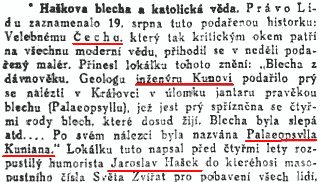
The polemic between Čas and Čech that Marek talked about actually took place but only after Hašek had left Svět zvířat. The prehistoric flea was authentic enough and the only sin Hašek committed was to change the name of it from Klebs' flea to Khún's flea! Curiously the news about the flea was printed on 1 September 1911, at a time when Hašek no longer worked for the journal.
,21.8.1913
After Hašek's death, many of his friends published their reminiscences, including colourful accounts of the ongoings at Svět zvířat.
Franta Sauer was the first of these and provides an interesting note about Engineer Khún's Flea. He claimed that Hašek himself wrote the notice in Právo lidu that eventually sparked the polemic between Čech and Čas (mentioned in The Good Soldier Švejk). This is entirely plausible and would be typical of Hašek! Sauer also claimed that the direct cause for Hašek's dismissal was that he had given readers bogus advice against some poultry disease and as a result, many birds died[g]. The magazine was allegedly flooded with complaints and even claims for compensation. Sauer's version remains unconfirmed and seems to be a mix of fact and fiction.
Concerning Svět zvířat, the by far most reliable information was put in print by Ladislav Hájek in 1925. As already mentioned was the editor of the journal both before and after Hašek's intermezzo and as directly involved few knew better the circumstances around Hašek's engagement at the journal and also his demise. Hájek's account is generally factual although chronologically vague. One surprise is his claim that Hašek "invented a fly with sixteen wings"[a], an creature that so far has not been identified in the columns of Svět zvířat.
In 1928 Emil Artur Longen added considerable spice to the legends. The werewolf again raised its bristles, Hašek had allegedly found a prehistoric flea in a piece of amber and had invented animals with the adroitness of the Creator himself[h]. Every issue of Svět zvířat is said to have contained some surprise and angry readers returned the magazine...
In 1935 Václav Menger followed up with more news. Hašek had allegedly written an item called Rational Breeding of Werewolves and also offered his creations for sale. Menger informed that Hašek had published an April Fools' Day joke photomontage that showed the Vltava below Vyšehrad being flooded with muskrats (ondatra) and that people had flocked to the river to watch the rare animals. Hašek had also allegedly transformed the serious magazine Svět zvířat into an entertainment periodical, and that within a few issues...[i]. Muskrats (ondatra) in the Vltava. This April Fools' photo montage with an accompanying text is mentioned in at least two biographies on Hašek (Menger, Parrott), albeit in somewhat twisted guises. It was however printed on 1 April 1914 and it is thus unlikely that Hašek had anything to do with it. Parrott didn't even notice that it was a joke.
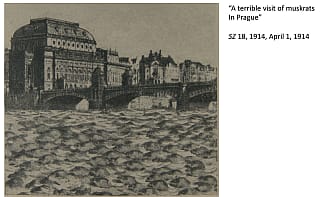
Although being largely at odds with reality, Václav Menger's version is important in the sense that it was passed on to foreign readers through the Hašek-biographies of Gustav Janouch (1966), Cecil Parrott (1978), and Jan Berwid-Buquoy (1989).
After World War II Gustav R. Opočenský, Josef Lada, and František Langer published their reminiscences but only Lada seems to provided details about Hašek's time above Klamovka. Lada informs that Hašek made him into a translator of Hungarian and published poems using his name! This is indeed true[u][v] but his claim that Hašek also made him into a translator of Permyak has not been verified.
In addition, Lada blew the story of Engineer Khún's Flea out of all proportion by claiming that it was a detailed article written by Hašek himself. The flea story was allegedly translated into foreign languages and caused a heated debate amongst scientists abroad!
When stating that biographers added spice space it would be wise to ponder where the amusing but nonsensical information actually hailed from. The likely source is of course Jaroslav Hašek himself. Still, this doesn't rule out that some of his friends added a tune or two! That Mach, Sauer, Longen, Menger and Lada actually studied Svět zvířat in detail seems very unlikely. The Bad Bohemian, ,1978
Significantly, much of the incorrect information from Menger and Lada hit the international stage years later via The Bad Bohemian (1978) by Cecil Parrott, so far the only English-language biography written about Jaroslav Hašek. In this generally solid book, Parrott unreservedly passed on the stories about the werewolves and the muskrats, and in the latter case, he even left out Václav Menger's note that it was an April Fool's joke. In addition, some of Josef Lada's equally improbable claims (e.g. about Engineer Khún's Flea), reached the anglophone readership through this book. Parrott in this book however never claimed that Hašek invented animals, but in the introduction to his translation of The Good Soldier Švejk (1973), he had done so.
Radko Pytlík was more prudent and stated that "at first sight, it is not obvious what is a prank and what is a mere curiosity" (Toulavé house, 1971). Despite this sombre precaution the distinguished scholar concluded, without providing further evidence, that Hašek invented animals...
Abenteuer auf Deutsch
The two German-language biographies about Jaroslav Hašek that exist as of 2024 both present an even more distorted picture. Both include dialogues between Fuchs and Hašek as if the authors were flies on the wall above Klamovka in 1908 and listened in on the conversation... ,1966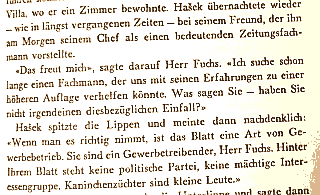
The first ever foreign-language Hašek-biography was published by Gustav Janouch in 1966. The book is well-written, and contains a wealth of information, a comprehensive literature list and also references[y]. Still, the section about Hašek and Svět zvířat is of dubious veracity (pages 88-94). The quoted conversation between Fuchs and Hašek (with Hájek present) raises many questions: Did Janouch simply invent the dialogue, or did he have some source? He could at a push have spoken to Hašek at some stage but not to Fuchs. He quotes Hájek but his book doesn't reproduce such a conversation at all[a]. Already the first issue of Svět zvířat that Hašek edited is claimed to have caused circulation to skyrocket (borrowed from Václav Menger?). Even the famous picture of Emperor Franz Joseph I. on the bridge is claimed to have been published by Hašek in Svět zvířat in 1909. This is of course pure nonsense, the picture was printed in several magazines in 1901 and is not to be seen in Svět zvířat (see starý Procházka)! Janouch was still thorough enough to quote his source: some former police director, now living in Karlovy Vary, Jan Chudoba! The result is thereafter...
,1989
Hašek had allegedly also transformed Svět zvířat into a humour magazine, again the echo of Václav Menger lingers... In short, Janouch twisted Ladislav Hájek's account drastically to make it more "interesting". Needless to say, Hašek's own mystifications about his time at Svět zvířat also creep in, for instance, the werewolves. Janouch was well connected amongst Hašek friends, he knew Sauer and Zdeněk Matěj Kuděj and the journalist Michal Mareš but none of them was in much contact with Hašek during his time at Svět zvířat so whatever they told him could at best be second-hand information and probably mere hearsay.
The second biography written in German was penned by Jan Berwid-Buquoy in 1989 and also deals with the theme Svět zvířat and Hašek (pages 150-158)[z]. It is arguably the most entertaining book about Hašek ever written but correspondingly speculative and unreliable fact-wise. First of all, it reproduces Janouch's "conversation" between Fuchs and Hašek, but with added spice (two beers become five). Then Hašek is even declared the inventor of the term "Werwolf - vlkodlak"! The author also mixes up the roles of Hájek and Hašek concerning Fuchsová and adds some of the better-known legends that Hašek himself created, like the terrible guzzler.
As previously mentioned, the legends as expressed in German existed already at least from from 5 January 1923. That day some writer K. (Egon Erwin Kisch ?) published Hašek's obituary in Prager Tagblatt an released into the German speaking world Hašek's werewolves and even mermaids that he allegedly advertised in Svět zvířat![zz]
Disintegrating legends

Hašek is the most likely source of most of the legends about his time as editor of Svět zvířat. Here he claims to have advertised young werewolves for sale in the journal.
,6.6.1912
With Svět zvířat becoming available and searchable online in May 2024 the vast majority of the myths surrounding Hašek and his contributions to the journal starts to fall apart.
Already before this, Dr. Martin Dvořák had studied and presented Svět zvířat at conferences in Lipnice and Kraków (June and November 2023). The owner of this website owes Dvořák a great deal for benevolently sharing his personal scans of the magazine (November 2023).
As Dvořák noted already in 2023: in the Svět zvířat there are no signs of werewolves or any of the other creatures that Hašek claims to have invented, be it as Einjährigfreiwilliger Marek in The Good Soldier Švejk, in his short stories, or in the words of his friends and biographers. The sulphur-bellied whale is mentioned but in a matter-of-fact context (it is another name for blue whale) and the same goes for the muskrats, jays etc. Marek's and Hašek's zoological creations are conspicuously absent.
Why was Jaroslav Hašek dismissed?
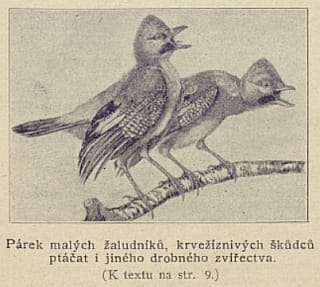
A pair of young acorners. Creating a new term for the jay in 1909 could not have been the reason for Hašek's dismissal more than a year later.
,15.7.1909
As usual, when Jaroslav Hašek is the theme conflicting testimonies abound. Based solely on reading The Good Soldier Švejk one might conclude that Hašek, as the real-life counterpart to Einjährigfreiwilliger Marek, was thrown out of Svět zvířat because of the affair with Engineer Khún's Flea combined with the invention of the new term acorner (instead of jay). Creating new species and providing alarming stories about bee- and poultry diseases also contributed to Marek's fall from grace.
Sauer claims that the final straw for Fuchs was some advice given in the journal about remedies against poultry disease, but this seems improbable and sounds like an echo from The Good Soldier Švejk.
The episodes regarding the pre-historic flea and the jay indeed took place but they could not possibly have contributed to Hašek leaving the magazine in October 1910. The flea controversy surfaced in 1913 and the affair with the jay happened already in 1909.
Václav Menger claims that the final straw for the journal's owner was an article Hašek had written where he wrote that muzzles on dogs causes rabies! Allegedly a reaction was printed in Národní politika. An article about muzzles and rabies indeed appeared in Svět zvířat on 1 August 1909 but it was signed Václav Fuchs himself! Hašek was capable of the most incredible mischief but surely he wouldn't have the audacity to publish such a story in his employer's name... Even if he did write the article the timing rules out that it provoked his dismissal more than a year later.
Ladislav Hájek offers a more mundane explanation: Hašek's irregular presence in the office and complaints from readers about dubious information were understandably more than the magazine owner Fuchs could tolerate[a]. In other words: Hašek was fired because he didn't do his job properly. This is also the most likely explanation.
Support for this hypothesis is found in the afterword to The Entertaining and Educational Corner of Jaroslav Hašek. Here Radko Pytlík concludes that researchers could not find any proof as to why and when Hašek left the journal. Nor did they on its pages identify any specific mystification that could have been a cause for termination[q].
Nepodařilo se však najít důkaz, proč a kdy Hašek z tohoto listu odešel. Hájek líčí, že majitel Světa zvířat byl prý nespokojen s jeho lehkovážným vedením listu; ale konkrétní mystifikaci, která by mohla být záminkou k výpovědi, jsme v listě nenalezli.
Radko Pytlík, 1973
Conclusion
Studying Svět zvířat and verifying the content against what has been written about it and Hašek over the years is still (2024) work in progress. It is thus apt to emphasize that although we have seen no evidence that Jaroslav Hašek invented new animal species, it still can't be entirely ruled out. Nor is the OCR technology that creates searchable digitized journals perfect yet.
In the end, the only pranks that have been identified narrow down to an unknown number of little jokes like making Josef Lada a poet and a translator of Hungarian and letting the natives blow up the baby hippo's nostrils. In the same category is Engineer Khún's Flea. In addition, in the journal can be found numerous items that appear to be pranks but may just as well be selected curiosities. Thus there is scope for further investigations.
That said, it is safe to conclude that Hašek largely mystified his famous animal mystifications, be it in The Good Soldier Švejk, his short stories or his revelations in Strana mírného pokroku v mezích zákona. Cecil Parrott sensibly concluded that Hašek was an "accomplished and persuasive hoaxer". Little did the respected Hašek expert know that he, like numerous others, indirectly fell into the trap by passing on the myths produced by Václav Menger and Josef Lada, "information" that surely Hašek himself set in circulation!
Perhaps the animal mystifications that Hašek allegedly published in Svět zvířat are in themselves his most accomplished and persuasive hoax ever? Engineer Khún's Flea is the outstanding show-case but the creature is in good company. By liberally twisting the account of his own activities in the journal Hašek has for more than 100 years fooled the entire range of literature experts, journalists, his friends and contemporaries, biographers, academics, bloggers, web site owners (this one included), Wiki-writers, gossip-makers, school teachers, university professors (the list is endless). They (or rather we) all believed that he actually published in Svět zvířat those fantastic stories - about werewolves, about Einjährigfreiwilliger Marek's inventions, about other phantom creatures, for instance the frightful guzzler. At the moment of writing I can't even think of anyone who didn't fall into the trap. By writing this I do not claim that the mentioned categories of readers and researchers are particularly stupid or gullible. They are rather the opposite - mostly very knowledgable and educated people. The whole history of Jaroslav Hašek and Svět zvířat is therefore a testimony to Hašek's unusual talent as a hoaxer!
Quote(s) from the novel
[II.3] Jednoroční dobrovolník chvíli o něčem přemýšlel a pak se obrátil na zdrceného desátníka: „Jestlipak znáte časopis ,Svět zvířat’?“
[II.3] Jak jsem se vlastně stal kdysi redaktorem ,Světa zvířat’, onoho velice zajímavého časopisu, bylo pro mne nějaký čas hádankou dosti složitou do té doby, kdy jsem sám přišel k tomu názoru, že jsem to mohl provést jen ve stavu naprosto nepříčetném, ve kterém jsem byl sveden přátelskou láskou ku starému kamarádovi Hájkovi, který redigoval do té doby poctivě časopis, ale zamiloval se přitom do dcerušky majitele časopisu pana Fuchse, který ho vyhnal na hodinu pod tou podmínkou, že mu zaopatří redaktora pořádného.
[II.3] Prohlásil jsem, že jsem již velice mnoho přemýšlel o správném vedení takovéhoto časopisu, jako je ,Svět zvířat’, a že všechny ty rubriky a body dovedu plně reprezentovat, ovládaje zmíněné náměty.
[II.3] Vycházel jsem z toho principu, že na př. slon, tygr, lev, opice, krtek, kůň, čuně atd. jsou dávno již každému čtenáři ,Světa zvířat’ úplně známými tvory.
[II.3] Mohu vás ubezpečit, že jsou vůbec čtenáři ,Světa zvířat’ velice zvědaví.
[II.3] Z této nepatrné události vyvinula se veliká polemika mezi ,Časem’ a ,Čechem’, poněvadž ,Čech’ v rozmanitostech ve svém feuilletonu, cituje článek o bleše mnou objevené, prohlásil: ,Co Bůh činí, dobře činí.’ ,Čas’ přirozeně čistě realisticky rozbil celou mou blechu i s velebným ,Čechem’, a od té doby zdálo se, že mne opouští šťastná hvězda vynálezcova a objevitele nových stvoření. Abonenti ,Světa zvířat’ začali se znepokojovat.
[II.3] Můj šéf, pan Fuchs, seděl jako vždy v kavárně a četl krajinské noviny, poněvadž poslední dobou náramně často hledal zmínky o mých poutavých článcích ve Světě zvířat, a když jsem přišel, ukázal na ležící na stole ,Selský obzor’ a řekl tiše, dívaje se na mne svýma smutnýma očima, který výraz měly jeho oči stále poslední dobou.
[II.3] Četl jsem klidně dál: ,Nato jsem od vašeho redaktora ,Světa zvířat’ obdržel dopis nesmírně hrubého, osobního a neomaleného rázu, kde jsem byl nazván trestuhodně ignorantským hovadem, což zasluhuje pokárání důrazného. Tak se neodpovídá na věcné vědecké výtky mezi slušnými lidmi. Rád bych věděl, kdo je z nás obou větší hovado. Snad, pravda, neměl jsem činiti výtky dopisnicí a dopsati listem, ale pro nával práce nevšiml jsem si té malichernosti, ale nyní po sprostém výpadu vašeho redaktora ,Svět zvířat’ vedu na veřejný pranýř.
[II.3] Než to jsou věci vedlejší, ač by zajisté nebylo na škodu, kdyby se váš redaktor ,Světa zvířat’ dříve přesvědčil, komu vytýká hovadinu, nežli nájezd vyjde z pera, třeba je určen na Moravu do Frýdlandu u Místku, kde byl do tohoto článku též odbírán váš časopis.
[II.3] Sojka zůstane sojkou, i kdyby se redaktor ,Světa zvířa’ z toho podě..l, a zůstane to jen dokladem, jak lehkomyslně a nevěcně se leckdys píše, byť by se i on dovolával Brehma nápadně neurvale.
Credit: Martin Dvořák, Jaroslav Šerák, Radko Pytlík, Alena Kráčmarová, Jindřich Toman
Also written:The Animal WorldenDyreverdano
Literature
- Svět zvířat, ,1909
- Svět zvířat, ,1910
- Svět zvířat, ,1912
- Svět zvířat, ,1913
- SNKC/Seriály - Úplné zobrazení záznamu, [t]
- Bibliografie Jaroslava Haška, ,2024 [d]
- Pobytové přihlášky pražského policejního ředitelství, ,1851 - 1914 [b]
- Jaroslav Haška zoologická zahrada,
- Malá zoologická zahrada, ,1950 [r]
- O dětech a zvířátkách, ,1960
- Zábavný a poučný koutek Jaroslava Haška, ,1973 [q]
- Svět Zvířat, ,1982
- O jednom hrozném psu, Jaroslav Hašek,15.2.1909
- Milostný román lidoopa konsula Petra, ,15.5.1909
- Moderní lov velryb, Frant. Winter,1.6.1909 Über Land und Meer, 1909
- Účinek hudby na zvířata, ,15.6.1909
- Oslík Guat, Jaroslav Hašek,15.6.1909
- Opilství mezi zvířaty, ,1.8.1909 Debatable authorship
- Objevení severní točny, Jaroslav Hašek,15.9.1909
- Vítězný boj o severní točnu, ,1.10.1909 Debatable authorship
- Štědrý večer Jana Gočvary a Michala Beckovjana, Jaroslav Hašek,15.12.1909
- Karikatury v říši zvířat, ,1.1.1910
- Akciová továrna na výrobu vajec, Laszló Emmere (Jaroslav Hašek),1.1.1910
- Sedm mudrců od východu uvažuje o škodlivosti alkoholu, ,1.1.1910
- Manželská věrnost v říši zvířat, Dr. Th. Zell,1.1.1910 Neues Wiener Journal, 11.12.1909
- Největší dravec světa, ,15.2.1910 Arbeiter-Zeitung, 5.2.1910
- O domýšlivém kocouru Bobešovi, Jaroslav Hašek,1.3.1910
- První apríl pana Fabiánka, Jaroslav Hašek,1.4.1910
- Vliv hudby na zvířata, Milka Langrová,1.5.1910
- Význam hospodářské výstavy pro povznesení chovu domácího zvířectva, Jar. Hašek,15.5.1910
- Jak pan Rosol fotografoval pytláka, A.K.,15.5.1910
- Utrpení zvířat, Dr. Vilém Stanko,1.6.1910
- Před ukončením školního roku, Jaroslav Hašek,1.7.1910
- Některé záhady pravěku, Jaroslav Hašek,15.8.1910
- Chirurgie a celní sazba, ,15.9.1910
- Sdružování mezi zvířaty, Jos. Pexider,15.10.1910
- Odstraňte bolest!, Vladmír Mayer,15.10.1910
- Na výstavě psů, Jaroslav Hašek,15.5.1912
- Z přírodopisu mrzutého profesora, Wilde,1.7.1912
- Vánoční noc v lese, Jaroslav Hašek,15.12.1912
- Silvestr zajíce s černou skvrnou na břiše, Jaroslav Hašek,1.1.1913
- Ohař pana barona, Jaroslav Hašek,1.2.1913
- Nač vše se děti ptají, J.H,1.2.1913
- O spletené rosničce, Jaroslav Hašek,15.2.1913
- O slepičce idealistce, Jaroslav Hašek,15.3.1913
- O nejošklivějším psu Balabánovi, Jaroslav Hašek,15.4.1913
- Kobyla Džáma, Jaroslav Hašek,15.5.1913
- Hroch, ,15.1.1909 [o]
- Přílišné citlivůstkářství, ,1.7.1909
- Žaludnici, ,15.7.1909 [n]
- Žraloci u Messiny, ,15.7.1909 [m]Prager Tagblatt, 6.7.1909
- Žaludníci nepřáteli bažantích vajec, ,1.8.1909
- Objevení nového zviřete, ,1.8.1909 Prager Tagblatt, 18.7.1909
- Zpěv čeledi havranů, ,1.10.1909
- Ze života učence Lombrosa, ,15.11.1909
- První žena, Isidor Kálnoky (Z maďarštiny přeložil J. Lada),15.11.1909 [u]
- Pod obraz boží, ,1.1.1910
- Letní píseň motylů, J. Lada,15.7.1910 [v]
- První pravěká stopa domácí kočky, ,1.10.1910
- Sešílela následkem štipnuti mouchou, ,1.9.1911 Plzenské listy, 21.8.1911
- Pravěká blecha, ,1.9.1911 [*]Neues Wiener Journal, 19.8.1911
- Sešílela následkem štipnuti mouchou, ,1.9.1911 Plzenské listy, 21.8.1911
- Kocour zachrancem, ,1.3.1912 Brněnské noviny, 19.2.1912
- Největší blechy, ,1.3.1913
- Z ranního cvičení našého chefredaktora s tygrem, ,1.4.1913
- Čemu se všemu nosorožec naučí, ,1.4.1913
- Naše aprilové číslo, ,15.4.1913
- Proměňování lidí ve zvířata, ,15.5.1913
- V přírodovědeckém časopise, Jaroslav Hašek,31.7.1911 [e]
- Svět zvířat, Jaroslav Hašek,1912
- Jak jsem vystoupil ze strany Nár. sociální, Jaroslav Hašek,14.3.1912
- Zvláštní zvíře, Jaroslav Hašek,6.6.1912
- Můj obchod se psy a jiné humoresky, ,1915
- Tři muži se žralokem, Jaroslav Hašek,3.4.1921
- Básník Louis Křikava, jinak Blažej Jordán zvaný, J. Hašek,3.10.1937
- Má nedražší Jarmilo!, ,10.7.1909
- Můj drahoušku Jarmilo!, ,27.7.1909
- Všecky druhy psů slovem i obrazem, ,1903
- Ze zašlých dob, ,1918 [f]
- Franta Habán ze Žižkova II., ,1923 [g]
- Z mých vzpomínek na Jaroslava Haška, ,1925 [a]
- Jaroslav Hašek, ,1928 [h]
- Jaroslav Hašek doma, ,1935 [i]
- Jaroslav Hašek. Der Vater des braven Soldaten Schwejk, ,1966 [y]
- Die Abenteuer des gar nicht so braven Humoristen Jaroslav Hašek, ,1989 [z]
- Toulavé house, ,1971
- Jasnozřivý génius a jeho slepý prorok, ,1983 [w]
- ......a hledal psinec a redakci "Světa zvířat", ,2010
- Jaroslav Hašek: Data, fakty, dokumenty, ,2013 [k]
- Photomontage as Visual Mystification: Jaroslav Hašek and The World of Animals, ,22.4.2023 [x]
- The Edible Ox, ,7.5.2016
- Haškův humor, ,2016
- Haškovy Osudy dobrého vojáka Švejka v italských překladech, ,2021
- Nový časopis, ,11.8.1897 [j]
- Svět zvířat in Jičín, ,18.9.1897
- V Jičině počal ..., ,1.10.1897
- Zřízení zoologické velezahrady stane se skutkem, ,28.11.1898
- Zpráva časopisecká, ,7.12.1898
- Reichsratsergänzungswahl, ,21.11.1908 [s]
- Ústřední stanice, ,6.12.1908
- Ochočení vlci, ,15.4.1909
- Der moderne Walfischfang, Franz Winter,1909 Nr. 32, page 144
- Der moderne Walfischfang, ,5.6.1909
- Hvad der fandtes i Haiens Mave, ,4.7.1909
- Der Hai von Messina, ,6.7.1909 [l]
- La voracita' din un mostro marino, ,26.7.1909
- Die Treue in der Tierwelt, Dr. Th. Zell,11.12.1909
- Časopis 'Svět zvířat' č. 297, ,15.10.1910 [c]
- Smutné konce českého žurnalisty, ,23.3.1912
- Blecha z dávnověku, ,12.8.1913
- Blecha z dávnověku, ,17.8.1913
- Haškova blecha a katolická věda, ,21.8.1913
- Haškova blecha a katolická věda, ,11.9.1913
- Jaroslav Hašek, ,5.1.1923 [zz]
- Život v přirodě, ,6.1.1925 [2]
- Rybí jikry, které se dávají vysedět kvočnám, ,20.7.1932
- Schwejk als Reporter, ,23.4.1933
- Pamětníci o Haškově životě, Zdeněk Šťastný,15.12.1957 [3]
- Great white enigma: In search of the Mediterranean’s giant sharks, Simon Ingram,22.7.2021 [p]
 | Čas |  | ||||
| Praha II./26, Jungmannova tř. 21 | ||||||
| ||||||
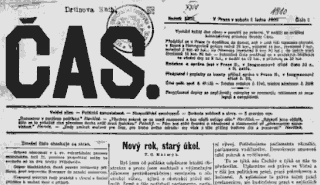
,1.1.1910
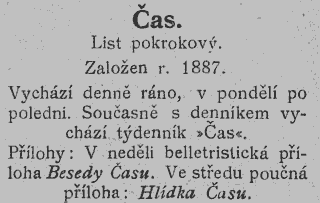
, 1907

,21.8.1913
Čas and Čech are both mentioned in connection with Einjährigfreiwilliger Marek's story about Engineer Khún's Flea. Marek "invented" the flea during his time as editor of Svět zvířat and Čech printed an article about it in good faith. Čas however understood that something was wrong and revealed the entire invention, causing a sharp polemic in the columns of the two newspapers. Unfortunately this episode turned out to be the beginning of the end for Marek's career at Svět zvířat.
Background
Čas was a newspaper that was founded in 1886 by Jan Erben and supported by a group of so-called realist politicians, amongst them Professor Masaryk and Kramář. From 1901 it was published as a daily. In 1915 it was barred from publishing, a fate that hit many Czech newspapers during the war.
Kún's flea
Einjährigfreiwilliger Marek's story about the flea is no doubt inspired by a little joke that Hašek "planted" in Svět zvířat in 1911, albeit at a time he when didn't work for the magazine[a]. The false story was printed in good faith by Čech two years later but was soon exposed by Právo lidu. Čas was one of several newspapers that reported on their mishap[b]. See Engineer Khún's Flea for details about this intriguing story!
Quote(s) from the novel
[II.3] Z této nepatrné události vyvinula se veliká polemika mezi Časem a Čechem, poněvadž Čech v rozmanitostech ve svém fejetonu cituje článek o bleše mnou objevené, prohlásil: ,Co Bůh činí, dobře činí: Čas přirozené čistě realisticky rozbil celou mou blechu i s velebným Čechem, a od té doby zdálo se, že mne opouští šťastná hvězda vynálezcova a objevitele nových stvoření.
Literature
- Pravěká blecha, ,1.9.1911 [a]
- Haškova blecha a katolická věda, ,21.8.1913 [b]
| a | Pravěká blecha | 1.9.1911 | |
| b | Haškova blecha a katolická věda | 21.8.1913 |
 | Čech |  | ||||
| Praha II./200, Pštrossova ul. 15 | ||||||
| ||||||
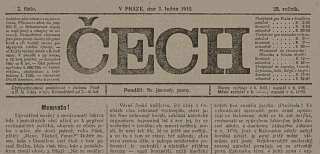
,3.1.1910

, 1907
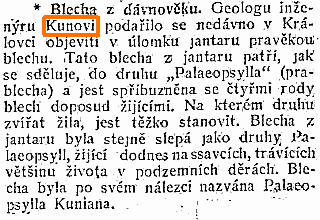
,17.8.1913
Čech and Čas are mentioned in connection with Einjährigfreiwilliger Marek's story about Engineer Khún's Flea. Marek "invented" the flea during his time as editor of Svět zvířat and Čech printed an article about it in good faith. Čas however understood that something was wrong and revealed the entire invention, causing a sharp polemic in the columns of the two newspapers. Unfortunately this episode turned out to be the beginning of the end for Marek's career at Svět zvířat.
Background
Čech was a Catholic-oriented daily with strong ties to Strana katolického lidu (The Catholic People's Party). The newspaper was established in 1869 as a weekly but already from 1873 ut was published every working day. During the years 1897 to 1903 it was called Katolické listy. After World War I the circulation fell and in 1937 Čech closed down for good.
It was one of the few major Czech newspapers that seems to have never printed any of Jaroslav Hašek's stories. On the other hand the author of The Good Soldier Švejk wrote several satirical pieces directed against the newspaper.
Kún's flea
Einjährigfreiwilliger Marek's story about the flea is no doubt inspired by a little joke that Hašek "planted" in Svět zvířat in 1911, albeit at a time he when didn't work for the magazine[a]. The misciveous story was printed in good faith by Čech two years later[b] but was soon exposed by Právo lidu. Čas was one of several newspapers that reported on their mishap[c] and Čech duly reacted with a long and rather irate response[d]. See Engineer Khún's Flea for details about this story!
Quote(s) from the novel
[II.3] Z této nepatrné události vyvinula se veliká polemika mezi Časem a Čechem, poněvadž Čech v rozmanitostech ve svém fejetonu cituje článek o bleše mnou objevené, prohlásil: ,Co Bůh činí, dobře činí: Čas přirozené čistě realisticky rozbil celou mou blechu i s velebným Čechem, a od té doby zdálo se, že mne opouští šťastná hvězda vynálezcova a objevitele nových stvoření.
Literature
- Pravěká blecha, ,1.9.1911 [a]
- Blecha z dávnověku, ,17.8.1913 [b]
- Haškova blecha a katolická věda, ,21.8.1913 [c]
- Novověká kukačka lapajicá pravěké blechy, ,22.8.1913 [d]
| a | Pravěká blecha | 1.9.1911 | |
| b | Blecha z dávnověku | 17.8.1913 | |
| c | Haškova blecha a katolická věda | 21.8.1913 | |
| d | Novověká kukačka lapajicá pravěké blechy | 22.8.1913 |
 | Selský obzor |  | ||||
| Ostrov u Macochy | ||||||
| ||||||

, leden 1910

, 27.2.1908
Selský obzor is mentioned by Einjährigfreiwilliger Marek when he relates about his time as editor of Svět zvířat. The paper's editor, Jos. M. Kadlčák wrote an angry editorial where he rebuffed Marek's renaming of the jay to "walnutter".
Background
Selský obzor (Farming Horizon) was a monthly that was published from 1902 to 1911. It was founded by the farmers Ševčík and Josef Šamalík (from 1907 a deputy in Reichsrat) and was the mouthpiece of Katolický spolek českého rolnictví na Moravě (Catholic Society of Czech Farming in Moravia) of which Šamalík was chairman. The first issue was published in February 1903 in Ostrov u Macochy (35 km north of Brno) where Šamalík lived. By 1907 Jos. M. Kadlčák had become editor of the magazine and the administration had relocated to Brno. The last issue appeared in March 1911.
No editorial in sight
It has not been possible to identify any editorial like the one that Einjährigfreiwilliger Marek talks about in The Good Soldier Švejk. All the issues of Selský obzor have been investigated to no avail, be it before, during or after Hašek's time as editor of Svět zvířat.
It must therefore be assumed that any dispute between Jaroslav Hašek and Jos. M. Kadlčák was in the form of personal correspondence. Perhaps Kadlčák even wrote directly to the magazine's owner Fuchs to make him aware of the excesses of his inventive editor. Another possibility is that Kadlčák wrote in one of the other periodicals of the Catholic Farming Society (Selské hlasy and Zemědelský obzor). Nor have any pictures of jays been identified in Svět zvířat from 1909 or 1910. That said the studies of these volumes have so far not been thorough enough for any firm conclusion to be drawn.
Quote(s) from the novel
[II.3] Poslanec Kadlčák odpověděl v ,Selském obzoru’ úvodním článkem. Můj šéf, pan Fuchs, seděl jako vždy v kavárně a četl krajinské noviny, poněvadž poslední dobou náramně často hledal zmínky o mých poutavých článcích ve Světě zvířat, a když jsem přišel, ukázal na ležící na stole ,Selský obzor’ a řekl tiše, dívaje se na mne svýma smutnýma očima, který výraz měly jeho oči stále poslední dobou.
Literature
 | Country Life |  | |||
| London, 20 Tavistock Street (now No. 8) | |||||
| |||||

© Country Life, 2022
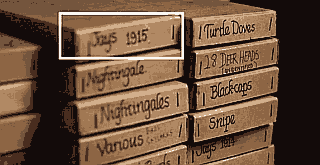
© Country Life, 2022

© Country Life, 2022
Country Life is mentioned by Einjährigfreiwilliger Marek when he relates his time as editor of Svět zvířat. From the English magazine Country Life, he had cut a photo of a jay sitting in a walnut tree and printed it, giving it the title "walnutter", a term he had invented himself. This caused a sharp reaction from Jos. M. Kadlčák, a clerical deputy in Parlament and editor of Selský obzor.
Background
Country Life was an English magazine founded in 1897 by the businessman Edward Burgess Hudson (1854-1936). Originally the name was Country Life Illustrated and the editorial offices were located at 20 Tavistock Street, central London. The magazine pioneered high-quality photos and glossy prints. It was an immediate success and the income permitted Hudson to erect a new building on the same site, a house that until today bears the name Hudson Building. In 1905 the magazine's editorial offices and print works were located here.
In the beginning, Country Life focused on horse racing, golf and other activities that were favourite pursuits amongst the upper classes. Still, it gradually introduced other subjects that were related to lifestyle, nature, and the countryside. The property section was also an important feature and many estates were advertised for sale in its columns. The magazine has been published uninterrupted throughout the years. In 2022 the magazine is located at another address in London.
With regards to Einjährigfreiwilliger Marek's cutting and pasting a picture of a jay sitting in a walnut tree: the archive of Country Life has a collection of photos of jays, dated 1915! The collection is not yet fully digitised so it has not been possible to ascertain from which issue of the magazine Marek (or rather Hašek) may have copied the picture. Nor has it been verified that such a photo ever appeared in Svět zvířat during Hašek's period as editor.
As a curiosity can be mentioned that the current internet issue of Country Life (April 2022) provides an entry by Simon Lester on the jay and other birds in the crow family![a]
Quote(s) from the novel
[II.3] Vystřihl jsem z anglického časopisu ,Country Life’ obrázek nějakého ptáčka, který seděl na ořechu. Dal jsem mu název ořešník, stejně jako bych se nijak logicky nerozpakoval napsat, že pták sedící na jalovci je jalovník, případně jalovice.
Literature
- Country Life web page,
- Edward Hudson: The tale of the man who founded Country Life, 125 years ago this month, Clive Aslet,15.1.2022
- Crows: Everything you need to know about the whole corvid family, from ravens and jackdaws to rooks, magpies, jays and choughs, Simon Lester,9.4.2022 [a]
| a | Crows: Everything you need to know about the whole corvid family, from ravens and jackdaws to rooks, magpies, jays and choughs | Simon Lester | 9.4.2022 |
 | Tunel |  | ||||
| Praha I./642, Týn 6 | ||||||
| ||||||
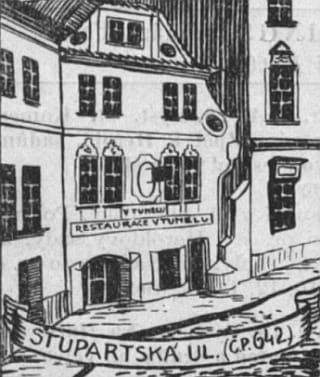
, 1929

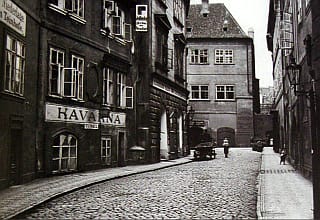
Tunel from Štupartská, around 1910

,8.3.1914
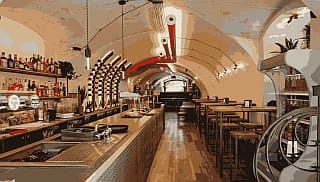
Tunel, 2022
© Tunel
Tunel is mentioned by Švejk when he coincidentally talks about orangutangs when the intellectual capabilities of the escorting corporal become the theme of the conversation on the train from Budějovice to Királyhida.
Background
Tunel was a café in Staré město that was located on the ground floor of the building U černého medvěda (At the Black Bear) behind the Týn church. It had two entrances, at Týn no. 6 and Štupartská no. 5. The official address was Týn 6 and in 1910 Františka Janusová (born 1854) was listed as the owner[d]. She moved to this address on 15 March 1907 but registered at another address already on 31 August 1911. Whoever succeeded her at Tunel in 1911 was presumably still managing it in 1914.
Address books confirm the existence of a restaurant in Týn no. 6 in these years: 1884, 1892, 1910, 1936 and 1946. In 2013 the address was occupied by an Indian restaurant and in 2022 there is a Tapas bar on the premises, appropriately named Tunel Restaurant & Tapas bar[c]. In 2024 this enterprise seems to have ceased, at least their web page is not operating.
Verbotene Lokale
In early 1914 Egon Erwin Kisch published the series Verbotene Lokale (Forbidden Taverns) in the newspaper Bohemia. It describes 11 establishments where soldiers from the Prague garrison were forbidden to enter. Three of these are mentioned in The Good Soldier Švejk: Apollo, U Kocanů and Tunel itself.
In the part of the series that Bohemia published on 15 March 1914, Kisch writes about Im Tunnel. He describes it as the worst of the worst, frequented by street prostitutes, thugs and other individuals from the lower echelons of society. The head waiter was the famous Jarda (Jaroslav), a huge bloke who enforced order at the premises by using brute strength and a bullwhip! Kisch himself witnessed a serious brawl there that was resolved when the landlord and the two waiters intervened, armed with Jarda's strength and the bullwhip. Kisch does not reveal the identity of the landlord.
On 22 April 1913, the military authorities added Tunel to their list of banned establishments but the only surprise for Kisch was that this had not happened even earlier. He also noted that Tunel once had been a decent restaurant and that he himself had enjoyed visiting it together with his fellow students[a].
In 1920 the series was reprinted in his book Die Abenteuer in Prag, collected under the title Konsignation über verbotene Lokale[b]. The story about Tunel was now slightly abridged and the author's Marxist interpretation of society shone through. He even pulls in Das Kapital and Das Kommunistische Manifest! Kisch had also removed the note about himself having frequented Tunel as a student.
E.E. Kisch: Konsignation über verbotene Lokale (1920)
Nun knöpfen wir uns den Kragen ab, denn unser weg führt in jenes der Lokale, das als letztes auf der militärischen Konsignation steht und wohl wirklich das letzte aller Prager Lokale ist. Hier hat die verfaulte unterste Schicht der relativer Überbevölkerung ihr Stammlokal, jene Menschen, die nicht mehr direkt als Opfer der kapitalistischen Akkumulation anzusehehen sind, jene, die Marx im "Kapital" Verbrecher, Verkommenene und Verlumpte, das eigentliche Lumpenproletariat nennt, und vor deren Käuflichkeit zu reaktionären Zwecken das Kommunistische Manifest warnt. Es ist erstaunlich, dass das Nachtcafé "Im Tunnel" (Stupartgasse Nr. 642, Teinhof) erst seit 22. April 1913 verboten ist.
Quote(s) from the novel
[II.3] „Zajisté,“ potvrdil Švejk, „vám zde nikdo neřek ani slůvka , který byste si mohl nějak křivě vykládat. Vono to vždycky špatně vypadá, když se někdo cítí uraženej. Jednou jsem seděl v noční kavárně v ,Tunelu’ a bavili jsme se vo orangutanech. Seděl tam s námi jeden mariňák a ten vyprávěl, že orangutana často nerozeznají od nějakýho vousatýho vobčana, že takovej orangutan má bradu porostlou chlupy jako... Jako,’ povídá, ,řekněme třebas tamhleten pán u vedlejšího stolu.’ Vohlédli jsme se všichni, a ten pán s tou bradou šel k mariňákovi a dal mu facku a mariňák mu rozbil hlavu flaškou od piva a ten bradatej pán se svalil a zůstal ležet bez sebe a s mariňákem jsme se rozloučili, poněvadž hned vodešel, když viděl, že ho přizabil. Potom jsme vzkřísili toho pána, a to jsme rozhodně neměli dělat, poněvadž hned po svým vzkříšení na nás všechny, kteří jsme přece s tím neměli prachnic co dělat, zavolal patrolu, která nás vodvedla na komisařství. Tam von pořád ved svou, že jsme ho považovali za orangutana, že jsme vo ničem jiným nemluvili než vo něm. A on pořád svou. My, že ne, že není žádnej orangutan. A von, že je, že to slyšel. Prosil jsem pana komisaře, aby mu to vysvětlil. A ten mu to zcela dobrácky vysvětloval, ale ani pak si nedal říct a řekl panu komisařovi, že tomu on nerozumí, že je s námi spolčenej. Tak ho pan komisař dal zavřít, aby vystřízlivěl, a my jsme se zas chtěli vrátit do ,Tunelu’, ale už jsme nemohli, poněvadž nás taky posadili za katr.
Credit: Hans-Peter Laqueur, Egon Erwin Kisch
Literature
- Románové restaurační a jiné zábavní podniky, ,2009 - 2021
- Verbotene Lokale, Egon Erwin Kisch,8.3.1914 [a]
- Konsignation über verbotene Lokale, ,1920 [b]
- Tunel, ,2022 [c]
- Pobytové přihlášky pražského policejního ředitelství, ,1851 - 1914 [d]
| a | Verbotene Lokale | Egon Erwin Kisch | 8.3.1914 |
| b | Konsignation über verbotene Lokale | 1920 | |
| c | Tunel | 2022 | |
| d | Pobytové přihlášky pražského policejního ředitelství | 1851 - 1914 |
 | Malý Čtenář |  | ||||
| Praha II./89, Spálená ul. 13 | ||||||
| ||||||
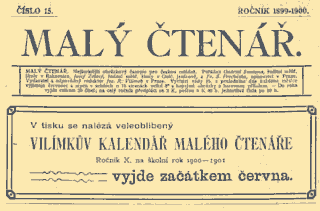
Malý čtenář, , 1899-1900
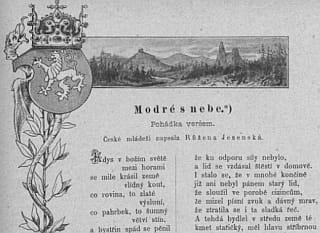
Story on verse by Růžena Jesenská
Malý čtenář, , 1889-1890
Malý Čtenář is mentioned in passing by Švejk when Einjährigfreiwilliger Marek ridicules the Korporal who escorted the two prisoners on the train from Budějovice to Bruck an der Leitha - Királyhida.
Background
Malý Čtenář (The Young Reader) was a magazine for children and youth that was published from 1882 to 1941. It first appeared in Poděbrady but from 1887 the Prague-based publisher Vilímek took over. The magazine appeared bi-weekly and contained illustrations, stories, and, as Švejk pointed out: poems. Several distinguished writers contributed to the magazine, amongst them Vrchlický and Růžena Jesenská, the latter before 1890. The publication had both educational and enlightening purposes and influenced entire generations of young Czechs.
The editorial office was located in Spálená ulice, not far from Teissig and c.k. zemský co trestní soud. In 1907 editor in chief was the publisher Vilímek himself, and the main co-editors were Gabriel Smetana, Josef Zelený, and František Procházka. The magazine continued operating until 1941 when it was closed by the Protectorate authorities.
Quote(s) from the novel
[II.3] „...kerej koberec vobjímá potůček,“ poznamenal Švejk, „a von pan desátník sliní tužku, sedí na nějakým pařezu a píše básničku do ,Malýho čtenáře’.“
Also written:The Young ReaderenDen une lesarno
Literature
- Malý čtenář, ,1884-1941
 | Landgericht |  | ||||
| Terezín, Prokopa Holého 78 | ||||||
| ||||||

, 1912
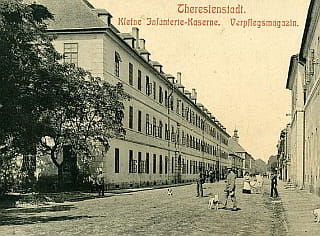
Kleine Infanteriekaserne in 1903. In 1914 this building also hosted Landwehrgericht

,20.12.1913
Landgericht in Terezín features in one of Švejk's anecdotes on the train from Budějovice to Királyhida. It was from his time doing military service in 1912 when he was unfairly accused of writing: "we'll shit on the war" on a wall by a munition dump. Švejk was tried at Landgericht in Terezín because of his alleged scribbling.
Background
Landgericht (Regional Court) was a judicial institution that did not exist in 1912. Courts thus named were once present in Austria but only until 1848[c]. The similar-sounding Landesgericht existed, but this institution covered all of Bohemia and was located in Prague (see c.k. zemský co trestní soud). It also appears odd that a military case was heard in a civilian court, and particular when considering that no such court was located in Terezín.
Landwehrgericht
These contradictions are best explained by assuming that Švejk had k.k. Landwehrgericht (Home Defence Court) in mind and simply got the terms mixed up. Such a court was indeed present in Terezín[a] and there was also a Garnisonsgericht[b]. That Švejk actually was talking about a military court becomes clear in the subsequent lines where he directly uses the term vojenský soud.
Landwehrgericht in Terezín was one of 13 of its kind in Austria (in Hungary Honvéd had their own courts). It was according to Schematismus from 1914 located in Kleine Infanteriekaserne (malá pěchotní kasárna)[a]. In 1912 the head of the court was Major Josef Kučera, and by 1914 his position was taken by Josef Wollmann. At the time of writing (2022) the barracks are called Kasárny Prokopa Holého and serve as storage for the Czech National Museum.
Trials
It is quite likely that Švejk's story is inspired by something that Hašek had read or heard about. Still, it has not been possible to identify any obvious example. Before the war, these trials were rarely covered by the press but were more frequently mentioned from August 1914 onwards. It is also evident that Landwehrgericht had the power to judge civilians who were suspected of betrayal. It is however unlikely that a soldier from Infanterieregiment Nr. 91 (that Švejk surely served in also in 1912) would have been put on trial in Terezín and not before the equivalent court in Prague under which jurisdiction his regiment belonged.
Quote(s) from the novel
[II.3] Nešťastnou náhodou ještě nad tím nápisem byl jinej: ,My na vojnu nepůjdeme, my se na ni vyséreme’, a to bylo v roce 1912, když jsme měli jít do Srbska kvůli tomu konsulovi Procházkovi. Tak mě hned poslali do Terezína k landgerichtu. Asi patnáctkrát tu zeď od magacínu s těma nápisama i s mým podpisem páni od vojenskýho soudu fotografovali, desetkrát mně dali napsat, aby zkoumali můj rukopis: ,My na vojnu nepůjdeme, my se na ni vyséreme’, patnáctkrát musel jsem psát před nimi ,Supák Schreiter je hnát’ a nakonec přijel jeden znalec písma a dal mně napsat: ,Bylo 29. července 1897, kdy Králový Dvůr nad Labem poznal hrůzy prudkého a rozvodněného Labe’.
[II.3] „To je vidět,“ řekl desátník s uspokojením, „že přece jen nezůstalo to bez trestu, že jste pořádnej kriminálník. Já bejt na místě toho landgerichtu, napařil bych vám ne šest neděl, ale šest let.“
Also written:Regional Courten
Literature
- Schematismus der k.k. Landwehr (s. 110), ,1914 [a]
- Schematismus für das k.u.k. Heer (s. 126), ,1914 [b]
- Landgericht (Österreich), [c]
- Malá pěchotní kasárna,
| a | Schematismus der k.k. Landwehr (s. 110) | 1914 | |
| b | Schematismus für das k.u.k. Heer (s. 126) | 1914 | |
| c | Landgericht (Österreich) |
 | Kurýr |  | ||||
| Praha II./618, Štěpánská ul. 26 | ||||||
| ||||||
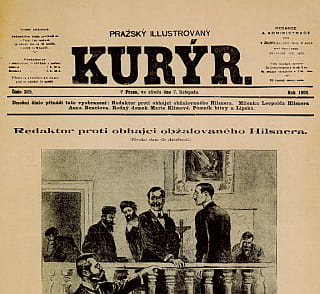

,1906
Kurýr is mentioned when Švejk on the train to Bruck reminded the escorting corporal about Koníček from Infanterieregiment Nr. 35 who years ago had stabbed his Korporal to death and then killed himself. Švejk had read about the incident in Kurýr.
Background
Kurýr almost certainly refers to Pražský illustrovaný kurýr, a pioneer boulevard daily[b] that was published from 1891 to 1918. It was associated with Hlas národa with whom they shared administration and editorial offices. The owner of both newspapers was Edvard Jan Baštýř (1861-1937), lawyer, publisher and politician. After Národní politika, Kurýr enjoyed the highest circulation of all Czech newspapers[a].
Hašek and the Baštýr press
As far as recorded, Jaroslav Hašek contributed only two stories to Kurýr (both in 1907) and none of his stories were printed by Hlas národa. Nor did he touch them much in his stories. The only recorded mention is also peripheral: a line about Baštýr and Hlas Národa in a story from 1916[c].
Martin Sekera, Český rozhlas, 28.10.2020
Mezi průkopníky tehdejšího bulváru patřil Pražský ilustrovaný kurýr, což byla příloha deníku Hlasu národa, který na první stránce zveřejnil senzaci nějaké patologie, ať už to byla vražda, neštěstí či mimořádný nadpřirozený úkaz. Kurýr tak ukojil hlad po senzaci i příběhu na pokračování a potěšil oko většinového čtenáře satirickými karikaturami.
Quote(s) from the novel
[II.3] „Pro tyhle samý věci, pro takový sekýrování, zapích před léty u pětatřicátýho regimentu nějakej Koníček sebe i kaprála. Bylo to v ,Kurýru’.
Literature
- Pražský illustrovaný kurýr, Jakub Machek,2012 [a]
- Jak se rodil bulvár aneb Co ještě snesete?, ,28.10.2020 [b]
- Ferrerova smrt a Pražský kurýr, ,17.10.1909
- Kovář Čekaj, Jaroslav Hašek,16.6.1907
- O Halálovi, tulákovi, Jaroslav Hašek,18.8.1907
- Povídka o obrazu císaře Františka Josefa I., Jaroslav Hašek,17.7.1916J [c]
| a | Pražský illustrovaný kurýr | Jakub Machek | 2012 |
| b | Jak se rodil bulvár aneb Co ještě snesete? | 28.10.2020 | |
| c | Povídka o obrazu císaře Františka Josefa I. | Jaroslav Hašek | 17.7.1916J |
 | K.k. Landwehrinfanterieregiment Nr. 64 |  | ||||
| ||||||
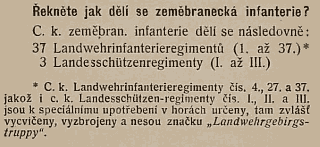
Proof that the 64th Landwehrregiment didn't exist
,1914
K.k. Landwehrinfanterieregiment Nr. 64 is mentioned by Feldoberkurat Lacina when he tells that he was served kidneys ala Madeira in the officer's dining room of this regimentet.
Background
K.k. Landwehrinfanterieregiment Nr. 64 was a unit that only existed in Lacina's imagination because k.k. Landwehr consisted of 37 regiments and these were numbered 1 to 37[a].
Only Hašek would know which k.k. Landwehr regiment the senior field chaplain really had in mind but if he had his dubious meal in Budějovice it would have been with officers from the city's k.k. Landwehrinfanterieregiment Nr. 29 (or k.k. Landwehrinfanterieregiment Nr. 6 from Cheb who replaced them on 19 June 1915).
If the meal was enjoyed in Kraków (where his Kavalleriedivision Nr. 7 was garrisoned) he may have endulged in the company of officers from k.k. Landwehrinfanterieregiment Nr. 16.
Quote(s) from the novel
[II.3] A tytéž ledvinky a la madeira jedl jsem v důstojnické mináži 64. landwehrregimentu. Dali do nich kmín, jako když se dělají v obyčejné hospodě na pepři. A kdo je dělal, čím byl ten kuchař v civilu? Krmič dobytka na jednom velkostatku.“
Literature
- Schematismus der k.k. Landwehr (s. 234), ,1914 [a]
| a | Schematismus der k.k. Landwehr (s. 234) | 1914 |
 | Na krásné vyhlídce |  | ||||
| Praha IV./156, Úvoz 31 | ||||||
| ||||||
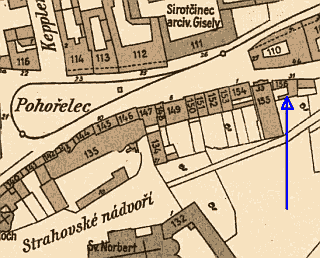
,1909-1914

,1891
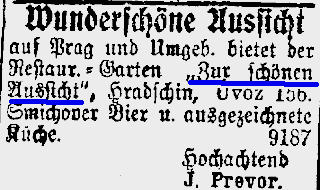
,22.7.1900

,1910

,31.7.1909

Krásná vyhlídka was in January 1927 entering the end of its existence. That same year the building was demolished.
,28.1.1927
Na krásné vyhlídce is mentioned when Švejk retells a story he had heard from a soldier who had reported sick by Przemyśl. During a bayonet charge he faced a huge Russian with a drop under his nose. When seeing the nose drop he felt unwell and was carried to Hilfsplatz. From here was dispatched to some cholera barracks in Pest where he actually contracted cholera! When recuperating in Prague the soldier told his story in the restarurant na Vyhlídce at Pohořelec and this is where Švejk picked it up.
Whereas Švejk used the term 'na Vyhlídce' when he first mentioned the pub but in [III.3] he uses the official name. This is in his endless anecdote about gardener Kalenda and Vyhlídka was one of the eight pubs that Kalenda visited on his "world tour".
Despite the minor difference between the names there is no doubt that Švejk talks about the same tavern.
Background
Na krásné vyhlídce (The Beautiful View) was a pub at Hradčany near the Strahov Monastery and Pohořelec. According to the address books from 1891 and 1910 it was located at Úvoz 31 and the description in The Good Soldier Švejk fits well with this spot. Landlord from 30 June 1898[e] and at least until 1912 was Josef Převor (b. 1864) but the restaurant had a history that stretched back to at least 1888[d] and it continued to operate until 1927. In 1900 an advert in Prager Tagblatt (see picture) reveals that they served beer from Smíchov (in modern times known as Staropramen).
In 1927 the old building was demolished[a] and from 1945 the new one hosts the embassy of Sweden and adjoining functions[b]. The site is one of the best outlook points in Prague with panoramic views of Hradčany, Malá Strana, Staré město, Nové město, Karlín, Žižkov etc. Both the old and the new building were called Na krásné vyhlídce. In some adverts the term Pěkná vyhlídka was also used[c].
Quote(s) from the novel
[II.3] „Někdy,“ řekl Švejk, „se zas v gefechtu člověku udělá špatně, člověk si něco zvoškliví. Vypravoval v Praze na Pohořelci na Vyhlídce’ jeden nemocnej rekonvalescent od Přemyšlu, že tam někde pod festungem přišlo k útoku na bajonety a proti němu se vobjevil jeden Rus, chlap jako hora, a mazal si to na něho s bajonetem a měl pořádnou kapičku u nosu. Jak se mu von podíval na tu kapičku, na ten vozdr, že se mu hned udělalo špatně a musel jít na hilfsplac, kde ho uznali zamořenýho cholerou a odpravili do cholerovejch baráků do Pešti, kde se taky vopravdu nakazil cholerou.“
[III.3] Počal se tedy dál a dál vzdalovat vod svýho domova, až se přivalil do ,Černýho pivovaru’ na Karlově náměstí, a vodtamtuď šel na Malou Stranu k Sv. Tomáši do pivovaru a odtamtud přes restauraci ,U Montágů’ a ještě vejš přes hospodu ,U krále brabanskýho’, pak na ,Krásnou vyhlídku’, odtud do Strahovskýho kláštera do pivovaru.
Also written:The Beautiful ViewenSchöne AussichtdeDen vakre utsiktno
Literature
- Románové restaurační a jiné zábavní podniky, ,2009 - 2021 [d]
- Soupis pražského obyvatelstva 1830-1910 (1920), [e]
- Kašna na terase švédského velvyslanectví, ,2000 [a]
- Ambassadanläggning i Prag, Tjeckien, ,29.4.2022 [b]
- Pěkná vyhlídka, ,4.3.1902 [c]
- Klenotnice Loretánská, ,7.7.1911
| a | Kašna na terase švédského velvyslanectví | 2000 | |
| b | Ambassadanläggning i Prag, Tjeckien | 29.4.2022 | |
| c | Pěkná vyhlídka | 4.3.1902 | |
| d | Románové restaurační a jiné zábavní podniky | 2009 - 2021 | |
| e | Soupis pražského obyvatelstva 1830-1910 (1920) |
 | Schönbrunner Menagerie |  | ||||
| Wien XIII./1 | ||||||
| ||||||
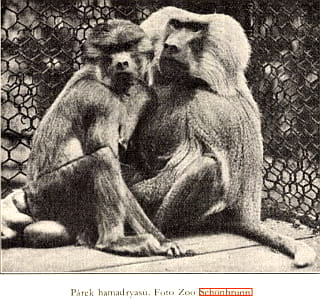
Zoo, ,1927
Schönbrunner Menagerie is mentioned by Švejk when he tells the escort corporal in the arrest wagon on the way from Budějovice to Királyhida that Vienna is an important city.
Background
Schönbrunner Menagerie was (and still is) a zoological garden on the grounds of Schönbrunn. It is now the main zoo in the city. Founded in 1752 it is the oldest existing of its kind in the world.
The Good Soldier Švejk in Captivity
Correspondingly the zoo is mentioned in Dobrý voják Švejk v zajetí, but also here only briefly.[1]
Po jednom takovém rozhovoru zdálo se v noci Švejkovi, že k němu přišel císař pán. Přijde a povídá: "Ohol mne, Švejku, v těchhle licousech vypadám jako orangutan z schönbrunnského zvěřince."
Quote(s) from the novel
[II.3] Vídeň je vůbec důležité město,“ pokračoval, „jenom co mají divokejch zvířat v tej schönbrunnskej menažerii. Když jsem byl před lety ve Vídni, tak jsem se nejradši chodil dívat na vopice, ale když jede nějaká osobnost z císařskýho hradu, tak tam nikoho nepouštěj přes kordon.
Also written:Schönbrunnské menažeriecz
Literature
- Tiergarten Schönbrunn,
- Dobrý voják Švejk v zajetí, ,1917 [1]
| 1 | Dobrý voják Švejk v zajetí | 1917 |
 | Hofburg |  | ||||
| Wien I./Hofburg | ||||||
| ||||||
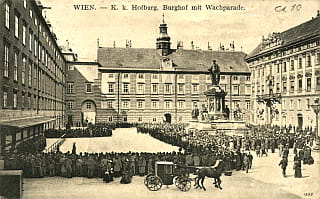
K. k. Hofburg; Burghof, Wachparade
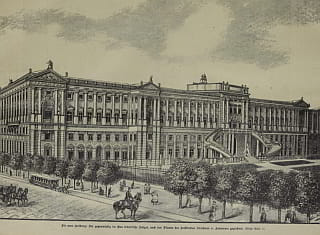
,13.3.1884

,26.7.1914
Hofburg is mentioned by Švejk through the term the imperial castle when he on the train from Budějovice to Királyhida touches on his experiences from the capital. When the corporal in the escort asks if he's been there he answers "no", but he had heard it's very beautiful. Members of Burgwache (the castle guards) must according to Švejk be about two metres tall and after finishing their service they are awarded a Trafika.
Background
Hofburg is not mentioned directly but there is no doubt that Švejk refers to Hofburg when he mentions the imperial castle. It is a castle or rather a complex of palaces in the centre of Vienna.
It was until 1918 the principal imperial palace of the Habsburg dynasty. It was built in the 13th century and expanded several times afterwards. It also served as the imperial winter residence, as Schönbrunn was the summer residence.
Since 1946 it is the official residence and workplace of the president of Austria. The large building complex also houses museums, chapels, the Spanish riding school, the National Library and other institutions.
The Good Soldier Švejk in Captivity
I Dobrý voják Švejk v zajetí Hofburg is just about mentioned because Franz Rypatschek, town counsiler from VI. Bezirk was arrested by the guarsd, totally naked and sent to the madhouse by Hall in Tyrol.[1]
Netrvalo to ani týden, odváželi Švejka do blázince v Hallu k dalšímu pobytu, kde byl zavřen též Franz Rypatschek, městský vídeňský radní ze šestého okresu, kterého jednou v noci zadržela hlídka u císařského hradu úplně nahého a pomalovaného fermežovými barvami.
Quote(s) from the novel
[II.3] Vídeň je vůbec důležité město,“ pokračoval, „jenom co mají divokejch zvířat v tej schönbrunnskej menažerii. Když jsem byl před lety ve Vídni, tak jsem se nejradši chodil dívat na vopice, ale když jede nějaká osobnost z císařskýho hradu, tak tam nikoho nepouštěj přes kordon. Byl se mnou jeden krejčí z desátýho okresu a toho zavřeli, poněvadž chtěl mermocí ty vopice vidět.“ „A byl jste taky ve hradě?“otázal se desátník. „Je tam moc krásně,“ odpověděl Švejk, „já tam nebyl, ale vypravoval mně jeden, kterej tam byl. Nejhezčí je z toho burgwache. Každej z nich prej musí bejt na dva metry vysokej a potom dostane trafiku. A princezen je tam jako smetí.“
Literature
- Hofburg,
- Dobrý voják Švejk v zajetí, ,1917 [1]
| 1 | Dobrý voják Švejk v zajetí | 1917 |
 | A railway station in Vienna |  | ||||
| Wien IX./Althanplatz | ||||||
| ||||||
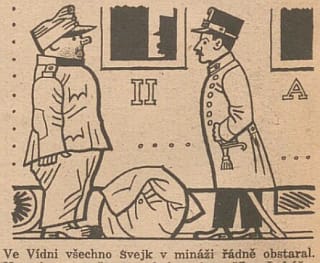
Švejk reunited with Lukáš at the station in Vienna.
,9.3.1924
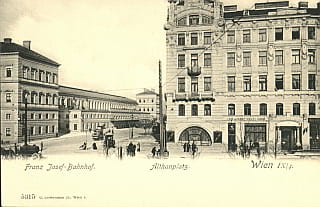
Wien, IX/4., Althanplatz, Franz Josef-Bahnhof, vor 1907
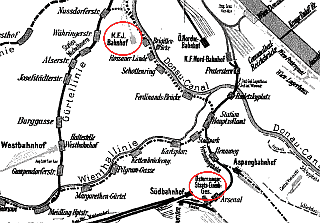
The railway network in Vienna around 1905
A railway station in Vienna refers to the station in Vienna where Švejk's transport on the way from Budějovice to Királyhida stopped and were given mess. This is also where Švejk was released after having been locked up for three days. At the station they were welcomed by representatives of Österreichische Gesellschaft vom Roten Kreuze, Magistrat der Stadt Wien and others who handed out pepper cakes with patriotic inscriptions.
Feldoberkurat Lacina sends Švejk on a mission to find some good food for him but at the station he meets Oberleutnant Lukáš who takes pity on him and takes him back as his servant. This meant that the good soldier took temporary leave with Einjährigfreiwilliger Marek and field chaplain Lacina disappeared from the story for good.
Background
A railway station in Vienna is from the plot in The Good Soldier Švejk alone impossible to identify because Vienna in 1914 had nine major railway stations and numerous smaller ones. The large ones were Aspangbahnhof, Donaukai, Franz-Josephs-Bahnhof, Kahlenberg-Eisenbahn, Nordbahnhof, Nordwestbahnhof, Ostbahnhof, Südbahnof and Westbahnhof[a].
Most of these can be ruled out for technical and topological reasons but it is likely that Švejk's transport stopped or passed at least two of the stations. Those that spring to mind are Franz-Josephs-Bahnhof and Ostbahnof. The former was connected to Budějovice and the latter eastwards to Királyhida and Hungary.
Josef Novotný's journey
On 1 June 1915 Ersatzbataillon IR. 91 were transferred from Budějovice to Királyhida and it happened largely according to the description in The Good Soldier Švejk. The journey is in rough terms lined out by Josef Novotný from Lišov who was one of the soldiers on the transport[b].
In his diary he noted that they left the barracks at 5-6 in the morning, that there was no public announcement of the departure but that a sizable crowd turned up to bid farewell to their house regiment. On the way to the station in Budějovice IR. 91 were guarded by "foreign troops"[1]. None of the soldiers in IR. 91 were allowed to carry sharp ammunition and the regiment's band was not allowed to play.
The soldiers were transported in cattle carriages, 50 to 60 men per wagon, and it took a while before they departed. They travelled via České Velenice and Gmund onto Sigmundsherberg where they early in the afternoon were given a meal. They continued down towards Danube and by Tulln they noticed fortifications along the railway line, a scene resembling the description in The Good Soldier Švejk.
The next stop was Franz-Josephs-Bahnhof and here a new meal was handed out, now at sunset[2]. It was getting dark and the journey through Vienna took a long time and they passed several stations that Novotný didn't name. He fell asleep around midnight and at 2 in the morning they finally arrived at the station in Királyhida. Here they remained in the wagons for another few hours.
Franz-Josephs-Bahnhof
In view of Novotný's description, there is little doubt that the station where Švejk was released and encountered his obrlajtnant was Franz-Josephs-Bahnhof. The transfer of the regiment did however take place in two stages. Thus one can't be sure that Novotný was on the same transport as Jaroslav Hašek but the itinerary would have been the same. In The Good Soldier Švejk one notices that between the station where Švejk and Oberleutnant Lukáš met and Királyhida there is no plot. This fits with Novotný's notes, that the passage through Vienna took place when it was dark. Thus Hašek would have seen little of Vienna that he could have fitted into the novel.
Quote(s) from the novel
[II.3] Přejeli nějaké nádraží, kde za nimi doznívaly zvuky rakouské hymny kapely, která sem přišla snad omylem, poněvadž teprve za hezkou dobu se dostali s vlakem na nádraží, kde se zastavili, byla mináž a bylo slavnostní uvítání.
[II.3] Potom byl rozkaz jít si pro mináž po rotách k polním kuchyním, které stály za nádražím.
Also written:BahnhofczEin jernbanestasjon i Wiennn
| 1. | Presumably k.k. Landwehrinfanterieregiment Nr. 6 Eger (now Cheb) who already in May had swapped garrisons with the local k.k. Landwehrinfanterieregiment Nr. 29. |
| 2. | Sunset in Vienna on 1 June is at 20:46. |
Literature
- Lehmanns Wohnungs-Anzeiger Wien, ,1915 [a]
- Grosser Plan von Wien, ,1909
- Franz-Josefs-Bahnhof,
- Z mých válečných pamětí, ,2021 [b]
- Der Wiener Bahnhoflabedienst, ,11.8.1915
| a | Lehmanns Wohnungs-Anzeiger Wien | 1915 | |
| b | Z mých válečných pamětí | 2021 |
 | Magistrat der Stadt Wien |  | ||||
| Wien I./Lichtenfelsg. 2 | ||||||
| ||||||
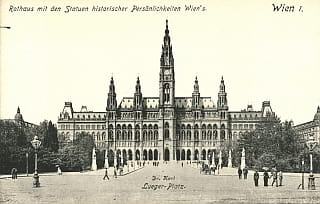
Rathaus, 1907
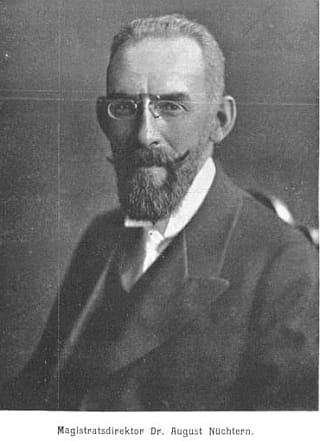
,17.8.1915
Magistrat der Stadt Wien is mentioned by the narrator in connection with the transport of Švejk's regiment from Budějovice to Királyhida. On a railway station in Vienna they were welcomed by three female members of Österreichische Gesellschaft vom Roten Kreuze, two members of some female war support society, and one representative of the city administration and the military authorities respectively. At the station the soldiers were given pepper cakes with patriotic inscriptions. Amongst those was Gott strafe England, a slogan that the reader of The Good Soldier Švejk will recognize from Baronesse von Botzenheim's sick visit in [I.8].
Background
Magistrat der Stadt Wien (Vienna City Administration) refers to the city administration of Vienna, headed by the Bürgermeister (mayor). The term Magistrat has been used since 1783 and still is. All statuary cities (15 in Austria, 27 in Czechia) are governed by a magistrat.
The executive of Magistrat was logically enough located in the city hall but such a large administrative body had many branches and was also represented in the 21 Bezirke (districts) of the capital. Mayor from 1913 to 1919 was Dr. Richard Weißkirchner (1861-1926) and director of the magistrate between 1914 and 1918 was Dr. August Nüchtern (1861-1929).
Quote(s) from the novel
[II.3] Uvítání ve Vídni sestávalo ze tří členkyň spolku Rakouského červeného kříže a ze dvou členkyň nějakého válečného spolku vídeňských paní a dívek, jednoho oficielního zástupce vídeňského magistrátu a vojenského zástupce.
Also written:Vienna City AdministrationenWien byforvaltningno
Literature
- Lehmanns Wohnungs-Anzeiger Wien, ,1915 [a]
- Magistrat,
| a | Lehmanns Wohnungs-Anzeiger Wien | 1915 |
 | Österreichische Gesellschaft vom Roten Kreuze |  | |||
| Wien I./Milchgasse 1 | |||||
| |||||

, 1915

Hartmann, A. Labedienst, 1915
© ÖNB
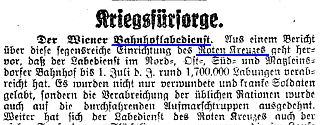
,11.8.1915
Österreichische Gesellschaft vom Roten Kreuze is mentioned by the narrator in connection with the transport of Švejk's regiment from Budějovice to Királyhida. On a railway station in Vienna they were welcomed by three female members of the Austrian Red Cross, two members of some female war aid society, and one representative of Magistrat der Stadt Wien and the military authorities respectively. At the station the soldiers were given pepper cakes with patriotic inscriptions. Amongst them was Gott strafe England, a slogan the reader of The Good Soldier Švejk will recognize from Baronesse von Botzenheim's sick visit in [I.8].
Background
Österreichische Gesellschaft vom Roten Kreuze was the official name of the Austrian Red Cross, the national branch of the International Red Cross. The society's orginated from Patriotische Hilfsverein that was founded in 1859 but the Red Cross in Austria was constitued as late as 1880. Patrons were Emperor Franz Joseph I. and Erzherzogin Marie Valerie, his daughter[a].
Bahnhoflabedienst
After the outbreak of war the Red Cross introduced aid centres at railway stations, amongst them Franz-Josefs-Bahnhof[b]. The name of this aid arrangement was Bahnhoflabedienst, an austrianism (roughly meaning support/care/rescue service at railway stations).
Franz-Josefs-Bahnhof is where Ersatzbataillon IR. 91 with Jaroslav Hašek stopped for mess in the evening of 1 June 1915, on the way from Budějovice to Királyhida. This suggests that this particular description of Švejk's break at a railway station in Vienna is authentic.
Quote(s) from the novel
[II.3] Uvítání ve Vídni sestávalo ze tří členkyň spolku Rakouského červeného kříže a ze dvou členkyň nějakého válečného spolku vídeňských paní a dívek, jednoho oficielního zástupce vídeňského magistrátu a vojenského zástupce.
Literature
- Lehmanns Wohnungs-Anzeiger Wien, ,1915 [a]
- Der Wiener Bahnhoflabedienst, ,11.8.1915 [b]
| a | Lehmanns Wohnungs-Anzeiger Wien | 1915 | |
| b | Der Wiener Bahnhoflabedienst | 11.8.1915 |
 | Brucker Lager |  | ||||
| Királyhida, Lagerstrasse | ||||||
| ||||||

Bruckneudorf, Militärlager - Übersicht Brucker Lager & Schloss Prugg 28.8.1897

,1913

Bruckneudorf, Militärlager, Geschütz-Abteilung in Feuerstellung

Officers from IR. 91 in Brucker Lager, 20 February 1918. Amongst them are two prototypes from the novel: Rudolf Lukas and Čeněk Sagner.
,7.3.1918

Gardehaus, former 2. Offizierskasino, 2010
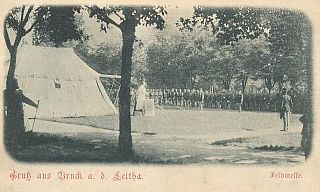
Bruckneudorf, Militärlager - Feldmesse
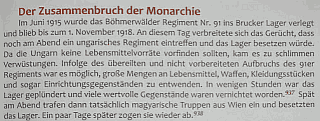
Bruck - Ujfalu - Királyhida - Bruckneudorf
,2011
Brucker Lager plays a vital part of the plot of The Good Soldier Švejk as the larger part of Part Two and the first chapter of Part Three takes place here. In total, more than a third of The Good Soldier Švejk is set in this camp and in the surrounding twin towns of Királyhida and Bruck. The author mostly uses the Czech word tábor when referring to the camp but the czechified German term lágr also appears. To judge by the text of The Good Soldier Švejk it is not clear where the camp was located but deputy Barabás places it in Bruck (it was actually in Királyhida).
Švejk and his transport would have arrived at night as the author states that night silence reigned over the camp. He also noted that in the men's barrack the soldiers shivered with cold whereas the officer's barracks were overheated so the windows had to be opened.
Background
Brucker Lager is a military camp and training ground in Bruckneudorf that was founded in 1867 and has been used continuously ever since. World War I saw the camp's most active period and at any time up to 26,000 soldiers were garrisoned here. This number dwarfed the combined populations of Bruck and Királyhida. During World War I the area also hosted a prisoner of war camp[c].
Jaroslav Hašek served in the camp throughout June 1915 and this explains why it became the backdrop for parts of The Good Soldier Švejk. The camp's commander from 1913 to 1918 was Oberstleutnant Wladimir Rollé, a person who may have lent his name to Auditor Ruller.
The camp consisted of wooden barracks that for the most part have been demolished since the time when Hašek served there. By far the largest part was Altes Lager (the old camp) that also housed Korpskommando. Neues Lager was much smaller and geographically separated from the old camp. It was established in 1873 and primarily used by the cavalry. Brucker Lager now (2010) exists as a military training ground, although parts of it has been turned into a nature reserve. The shooting range is one of the institutions that is still operaating.
In The Good Soldier Švejk many buildings, spots, and military institutions in the camp are mentioned. Amongst these we find (German terms): Lagerallee, Militärschießstätte, Hauptwache, Divisionsgericht, Divisionskommando, Mannschaftsbaracken, Offiziersbaracken, Offiziersmenage, Offiziersküche, Offizierskasino, and Rotes Kreuz[a].
IR. 91 in Brucker Lager
For Infanterieregiment Nr. 91 Brucker Lager was no ordinary training ground. In early 1915 it was decided that most regiments from Bohemia and Moravia were to be relocated to other parts of Austria-Hungary to avoid too much contact with the increasingly discontent Czech population. The Ersatzbataillon IR. 91 (replacement battalion) was thus transferred to Királyhida on 1 June 1915 and in Budějovice the Hungarian Infanterieregiment Nr. 101 replaced them.
Hašek's march battalion
The XII. Marschbataillon, to which Jaroslav Hašek belonged, was formed and trained here and left for the front on 30 June 1915. It was surely here in the camp that Hašek for the first time met Jan Vaněk, one of the best sources we have with regards to information about the author's time in k.u.k. Heer. It was also here that Rudolf Lukas from 1 June became Hašek's superior in the capacity of commander of the 4th march company.
Josef Novotný
One of the soldiers who was transferred to Királyhida on the same day as Hašek was Josef Novotný. Like Hašek he had been expelled from Budweiser Einjährigfreiwilligenschule and like the author of The Good Soldier Švejk he had a history of illness. He described the transport from Budějovice in detail and also the conditions in the camp. The transport arrived at Királyhida station at 2 in the night (2 June), but were kept in the carriages until dawn. This corresponds to Hašek's statement that "night silence reigned over the camp". The soldiers were housed in the barracks of Altes Lager (the old camp), decrepit wooden buildings with leaking roofs[b]. See Mannschaftsbaracken for more information.
After the war
When IR. 91 left the camp on 1 November 1918 they plundered it in order not to leave supplies on Hungarian hands, and a new round of destruction was inflicted in 1921 by Hungarian paramilitaries. During World War II the camp was again used for prisoners of war, and from 1944 Hungarian Jews and other forced labour were interned here[d].
The Good Soldier Švejk in Captivity
Brucker Lager and the surrounding twin towns are also the stage for three of the fourteen chapters of Dobrý voják Švejk v zajetí. The major common theme with The Good Soldier Švejk is the Kakonyi affair where Fähnrich Dauerling is the main character and not Oberleutnant Lukáš. The dog theft we know from the novel takes place in Bruck instead of Prague and again Dauerling is found in the role of Lukáš. The sequences that describe Dauerling and the brutal German junior officers Feldwebel Sondernummer, Korporal Althof and Gefreiter Müller are almost identical and the same goes for the description of Major Wenzl. Lukáš and Hauptmann Ságner merely linger on the periphery and characters like Rechnungsfeldwebel Vaněk, Sappeur Vodička and Oberst Schröder don't feature at all. The role of the latter is however taken by Oberst Schlager but is far less prominent. Kadett Biegler does feature but in a different role.[1]
Quote(s) from the novel
[II.3] Nad vojenským táborem v Mostě panovalo noční ticho. V barácích pro mužstvo třásli se vojáci zimou a v důstojnických barácích otvírali okna, poněvadž bylo přetopeno. Od jednotlivých objektů, před kterými stály stráže, ozývaly se občas kroky hlídky, která si plašila chůzí spánek. Dole v Mostě nad Litavou zářily světla z c. k. továrny na masité konservy, kde se pracovalo dnem i nocí a zpracovávaly se různé odpadky. Poněvadž šel odtud vítr do alejí ve vojenském táboře, šel sem smrad z hnijících šlach, kopyt, paznehtů a kostí, které vařili do polévkových konserv.
[II.3] V jednom z důstojnických baráků v táboře čekal v noci Švejk na svého nadporučíka Lukáše, který šel večer do města do divadla a doposud se nevrátil.
[II.3] Nyní byl přidělen k vojenské střelnici v Királyhidě jako velitel a měl také co dělat s hospodářstvím v táboře. Mezi důstojníky se vypravovalo, že si major Wenzl nyní pomůže na nohy.
[II.3] Nadporučík Lukáš neměl původně v úmyslu někde se zdržet. Šel kvečeru z tábora do města jen do maďarského divadla v Királyhidě,
[II.3] Najít Sopronyi utczu čís. 16 nebylo by bývalo tak těžké, kdyby ho náhodou nebyl potkal starý sapér Vodička, který byl přidělen k „štajerákům“, jejichž kasárna byla dole v lágru. Vodička bydlíval před léty v Praze na Bojišti, a proto při takovém setkání nezbylo nic jiného, než že oba zašli do hospody „U černého beránka“ v Brucku, kde byla známá číšnice Růženka, Češka, které byli všichni čeští jednoročáci, kteří kdy byli v lágru, nějaký obnos dlužni.
[II.3] Poslední dobou sapér Vodička, starý partyka, dělal jí kavalíra a měl v seznamu všechny maršky, které odjížděly z tábora, a chodil v pravý čas Čechy jednoročáky upomínat, aby se neztratili bez zaplacení útraty ve válečné vřavě.
[II.3] Potom nás dohonil až nahoře u samýho lágru a povídal, že vždycky myslel, že sou Maďarky vohnivější, ale ta svině že ležela jako pařez a pořád jen něco brebentila.
[II.4] Plukovník Schröder se zalíbením pozoroval bledý obličej nadporučíka Lukáše, s velkými kruhy pod očima, který v rozpacích nedíval se na plukovníka, ale úkradkem, jako by něco studoval, díval se na plán dislokace mužstev ve vojenském táboře, který byl také jedinou ozdobou v celé kanceláři plukovníka.
[II.4] K jaké národnosti patřili vojáci z nedalekého vojenského tábora v Brucku nad Litavou, kteří přepadli a ztrýznili tamějšího obchodníka pana Gyulu Kákonyie?
[II.4] Toto se týká zejména jednoho pána, který se dle doslechu zdržuje doposud beztrestně ve vojenském táboře a stále ještě nosí odznaky svého papageiregimentu a jehož jméno bylo též uveřejněno předevčírem v Pester Lloydu a Pesti Napló.
[II.4] Včera jsem eskortoval taky dva do lágru a někdo mně sežral půl veky, kterou pro mne vyfasovali.
[II.5] Pane rechnungsfeldvébl," pravil důstojně Švejk, "dovoluji si vám prohlásit, že vašemu rozkazu nemůžu vyhovět při nejlepší vůli klidit se třebas z celýho lágru, neboť já podléhám vyššímu nařízení.
Credit: Klara Köttner-Benigni, Petra Weiß
Literature
- Die „Abenteuer des Braven Soldaten Schwejk” in Österreich, ,1983 [a]
- Z mých válečných pamětí, ,2021 [b]
- 150 Jahre Brucker Lager/TÜPl Bruckneudorf - I, [c]
- 150 Jahre Brucker Lager/TÜPl Bruckneudorf - II, [d]
- Kde to bylo, ,6.4.1983
- Kaisers Geburtstag in Brucker Lager, ,24.8.1915
- Wohltätigkeitskonzert in Brucker Lager, ,21.9.1915
- Dobrý voják Švejk v zajetí, ,1917 [1]
 | Mannschaftsbaracken |  | ||||
| Királyhida, Lagerstrasse | ||||||
| ||||||

Bruckneudorf, Militärlager - Mannschaftsbaracke, Innenansicht
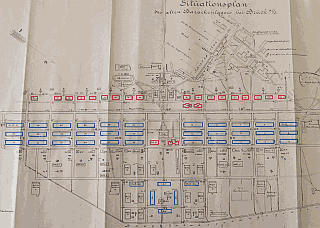
The men's barracks marked blue
,1908
Mannschaftsbaracken are mentioned when the author introduces Brucker Lager. In the barracks for the rank and file the men were shivering from cold, whereas the Offiziersbaracken where overheated so the windows had to be opened.
There is no indication that the plot took place here because Švejk was an officer's servant and would therefore stay with his superior in Offiziersbaracken.
Background
Mannschaftsbaracken refers to the men's barracks in Brucker Lager. These were found both in Altes Lager and in Neuer Lager but thanks to the notes of Josef Novotný we know that soldiers from Infanterieregiment Nr. 91 were lodged in wooden barracks in Altes Lager[a].
The men's barracks were found in the northern part of the camp, to the left of the Lagerallee (as approached from the main entrance of the camp). In 1908 the camp provided 39 barracks for the men[b].
The war led to big changes in the camp. Novotný's account[a] of conditions differs markedly from the impression of relative comfort one gets from pictures of the interior of the barracks. He noted that the barracks were overcrowded, that the soldier's slept on half rotten straw on the earth floor, so crowded that the men had to sleep three in a space intended for two. The roofs were leaking and the walls in part rotting.
Shivering from cold in june?
Hašek and his transport arrived on 2 June 1915 so it appears odd that the soldiers were shivering from cold at this time of the year. The weather reports (Vienna) reveal temperatures towards 26 degrees those days[c].
Quote(s) from the novel
[II.3] Nad vojenským táborem v Mostě panovalo noční ticho. V barácích pro mužstvo třásli se vojáci zimou a v důstojnických barácích otvírali okna, poněvadž bylo přetopeno.
Credit: Klara Köttner-Benigni, Petra Weiß
Literature
- Die „Abenteuer des Braven Soldaten Schwejk” in Österreich, ,1983
- Z mých válečných pamětí, ,2021 [a]
- 150 Jahre Brucker Lager/TÜPl Bruckneudorf, [b]
- Das Wetter, ,3.6.1915 [c]
| a | Z mých válečných pamětí | 2021 | |
| b | 150 Jahre Brucker Lager/TÜPl Bruckneudorf | ||
| c | Das Wetter | 3.6.1915 |
 | Offiziersbaracken |  | ||||
| Királyhida, Lagerstrasse | ||||||
| ||||||
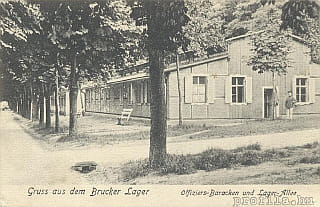
Bruckneudorf, Militärlager - Lagerallee mit Offiziers-Baracken

The officer's barracks a.o. marked red
,1908
Offiziersbaracken are mentioned when the author introduces Brucker Lager. Whereas in the Mannschaftsbaracken the men were shivering from cold, the officer's barracks were overheated so the windows had to be opened.
It was in one of these barracks that Švejk was in a conversation with Offiziersdiener Mikulášek when he was tasked by Oberleutnant Lukáš to deliver the fateful letter to Etelka Kakonyi. Major Wenzl and Lukáš stayed in the same barracks with their servant Mikulášek and Švejk.
Background
Offiziersbaracken refers to the officer's barracks in Brucker Lager. These were found both in Altes Lager and in Neuer Lager but thanks to the notes of Josef Novotný we know that soldiers from Infanterieregiment Nr. 91 were lodged in Altes Lager[a].
The officer's barracks were found in the northern part of the camp, to the right of the Lagerallee, seen in the direction from the main entrance. In 1908 the old camp had 20 officer's barracks[b].
Quote(s) from the novel
[II.3] Nad vojenským táborem v Mostě panovalo noční ticho. V barácích pro mužstvo třásli se vojáci zimou a v důstojnických barácích otvírali okna, poněvadž bylo přetopeno.
[II.3] V jednom z důstojnických baráků v táboře čekal v noci Švejk na svého nadporučíka Lukáše, který šel večer do města do divadla a doposud se nevrátil. Švejk seděl na odestlané posteli nadporučíkově a naproti němu seděl na stole sluha majora Wenzla.
Credit: Klara Köttner-Benigni, Petra Weiß
Literature
- Die „Abenteuer des Braven Soldaten Schwejk” in Österreich, ,1983
- Z mých válečných pamětí, ,2021 [a]
- 150 Jahre Brucker Lager/TÜPl Bruckneudorf, [b]
| a | Z mých válečných pamětí | 2021 | |
| b | 150 Jahre Brucker Lager/TÜPl Bruckneudorf |
 | Lagerallee |  | ||||
| Királyhida, Lagerstrasse | ||||||
| ||||||
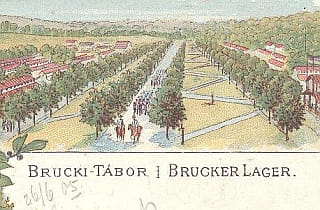
Lagerallee

,1913
Lagerallee is mentioned when the author introduces Brucker Lager. He explains that when the wind blows from the direction from k.k. Fleischkonservenfabrik down in Bruck the stench from the factory is noticed even up in the alley in the military camp.
Background
Lagerallee refers to a broad alley that stretches through Brucker Lager from the main entrance in Lagerstrasse and eastwards. It has streets on both sides and a green area with trees in the middle. On the southern side the Offiziersbaracken were, on the northern side Mannschaftsbaracken. Korpskommando, Hauptwache, Offizierskasino, and Militärschießstätte were also located along the alley.
Almost all the buildings on the northern side of the alley have long been demolished and Benedek-kaserne is now one of the buildings on the site.
Quote(s) from the novel
[II.3] Dole v Mostě nad Litavou zářily světla z c. k. továrny na masité konservy, kde se pracovalo dnem i nocí a zpracovávaly se různé odpadky. Poněvadž šel odtud vítr do alejí ve vojenském táboře, šel sem smrad z hnijících šlach, kopyt, paznehtů a kostí, které vařili do polévkových konserv.
Credit: Klara Köttner-Benigni, Petra Weiß
Literature
 | K.k. Fleischkonservenfabrik |  | |||
| Királyhida, Lagerstrasse 8 | |||||
| |||||
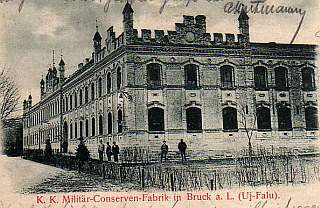
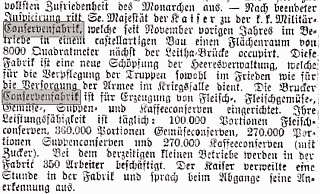
,2.6.1897
K.k. Fleischkonservenfabrik (the Royal-Imperial Meat tinning factory) is pungently described by the author in his introduction to Királyhida. Here they tin and make soup from sinews, hoofs and intestines, even rotten. When the wind blew from that direction the stench spread up to Lagerallee.
Background
K.k. Fleischkonservenfabrik refers to k.u.k. Militärkonservenfabrik, a tinning factory that operated from November 1896 in Királyhida. Thus it was not located in Bruck as stated in The Good Soldier Švejk and also belonged to the common military (k.u.k) and not to the military of Cisleithania as the abbreviation k.k. indicates.
Apart from meat it tinned vegetables, soups and coffee[a]. Emperor Franz Joseph I. honoured the factory with a visit already on 1 June 1897 in connection with an inspection of Brucker Lager. He spent more than an hour there and even sampled the produce.
At the time the factory had 350 employees but during World War I up to 3000 worked there, including prisoners of war. The running of the factory was outsourced to various enterprises and operation ceased with the end of the war.
In 2010 the 4,000 sqm building housed a shopping centre, a police office and a car accessory dealer, but most of it is no longer used.
The Good Soldier Švejk in Captivity
The factory is mentioned also in Dobrý voják Švejk v zajetí, but the description is less detailed. It is however explicitly (and wrongly) located in Bruck.[1]
Bylo to ale přece jen blíž. Přejde se Litavka v Brucku a již je člověk v 'magyarországu' červenozelenobílými sloupy. Sem táhne sice ještě zápach z velké c. k. továrny na konzervy v Brucku nad Litavou, dávaje Maďarům tušit, že tam za Litavou leccos prodělává hnilobný proces, ale míchá se tu se zápachem uherských prasat, která za tratí jsou vehnána do velkých ohrad a odtud s honvédy, honvédhusary a červenými husary dopravují se dále na frontu.
Klara Köttner-Benigni
In Királyhida war noch im Ersten Weltkrieg die „K.u.k. Militär-Conserven-fabrik” (im „Schwejk” „k.u.k. Fleischkonserven-fabrik”) in Betrieb. (S. 324) In ihr dürften sehr vorwiegend Fleisch-, Suppen-, Gemüse- und Kaffeekonserven hergestellt worden sein. Zumindest im Frieden waren die Rezepturen einwandfrei, wie Konrad Biricz nach deren Prüfung in Akten des Staatsarchivs (Kriegsarchivs) erklärt. Wegen kriegsbedingter Versorgungsschwierigkeiten wird die Qualität sicherlich schlechter geworden sein, aber die Bemerkung, daß dort — bereits 1915! — eine Mischung von stinkenden „verfaulten Sehnen, Hufen, Klauen und Knochen” zu „Suppenkonserven” verarbeitet wurde (S. 325), ist eine der grotesken Übertreibungen des Gourmets Hašek, dem es vor dem kulinarischen Massenbetrieb geekelt haben muß.
Quote(s) from the novel
[II.3] Dole v Mostě nad Litavou zářily světla z c. k. továrny na masité konservy, kde se pracovalo dnem i nocí a zpracovávaly se různé odpadky. Poněvadž šel odtud vítr do alejí ve vojenském táboře, šel sem smrad z hnijících šlach, kopyt, paznehtů a kostí, které vařili do polévkových konserv.
Credit: Petra Weiß, Klara Köttner-Benigni, Konrad Biricz
Literature
- Die „Abenteuer des Braven Soldaten Schwejk” in Österreich, ,1983 [a]
- Kde to bylo, ,6.4.1983
- Dobrý voják Švejk v zajetí, ,1917 [1]
- K.u.k. Militär-Conservenfabrik,
- Truppen-Inspizierung, ,1.6.1897
- Eine Militär Conserven-Fabrik, ,3.6.1897
- Dobrý voják Švejk v zajetí, ,1917 [1]
| a | Die „Abenteuer des Braven Soldaten Schwejk” in Österreich | 1983 | |
| 1 | Dobrý voják Švejk v zajetí | 1917 |
 | Militärschießstätte |  | |||
| Királyhida, Lagerstrasse | |||||
| |||||

Bruckneudorf, Militärlager - Schießschul-Baracken
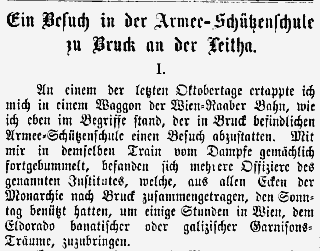
,4.12.1868
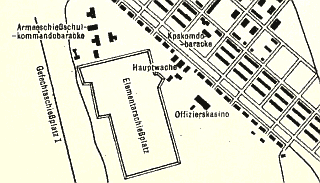
,1913
Militärschießstätte vert nemnd når forteljaren deler sine fyrste inntrykk frå Brucker Lager. Soon later it is revealed that Major Wenzl is the commander of the shooting range.
Background
Militärschießstätte (The military shooting range) refers to the shooting range in Brucker Lager that belonged to k.u.k. Armeeschieß-Schule (the Army shooting school). It was opened already on 1 September 1868, a year after the camp came into operation[a]. The instruction mainly regarded rifle shooting but also machine guns.
The shooting range was situated behind Offiziersbaracken in the southern direction. Commander in 1913 was Oberst Otto Bartusch from Infanterieregiment Nr. 36. Before the war, the shooting school in Brucker Lager was operating from May to September but this may have changed at the outbreak of war. The rest of the year they were based in Wien[b].
The shooting school was a central institution for the entire k.u.k. Wehrmacht and was during the pre-war years greatly expanded. How important the institution was can be seen by the fact the commanders of the camp had high ranks and Bartusch's predecessor even held the rank Generalmajor. At the time there were also discussions on de-centralising the shooting education due to capacity problems in Brucker Lager[d].
In June 1915
Who the commander was in the period that Jaroslav Hašek served in Brucker Lager (June 1915) is not known because Bartusch was called up for service at the outbreak of war[c]. According to The Good Soldier Švejk Major Wenzl was the commander of the shooting range (not necessarily the shooting school) and his prototype Franz Wenzel was in the camp as commander of XII. Marschbataillon. Before the war he had been head of the shooting range in Kutná Hora so there may be connection. Going against the assumption that Wenzel headed the shooting range is the short period he stayed here (4 weeks) and that the school commanders had much higher ranks than Major (at least before the war ). It is therefore unlikely that the occupied exactly this position but he may still have had a another position at the school.
Parts of the shooting school/range are still (2010) operating but obviously with a much lower lever of activity than in 1915.
Quote(s) from the novel
[II.3] Od opuštěného pavilónku, kde dřív za času míru fotografoval nějaký fotograf vojáky trávící zde mládí na vojenské střelnici, bylo vidět dole v údolí u Litavy červené elektrické světlo v bordelu „U kukuřičného klasu“, který poctil svou návštěvou arcivévoda Štěpán při velkých manévrech u Šoproně v roce 1908 a kde se scházela denně důstojnická společnost.
[II.3] Nyní byl přidělen k vojenské střelnici v Királyhidě jako velitel a měl také co dělat s hospodářstvím v táboře. Mezi důstojníky se vypravovalo, že si major Wenzl nyní pomůže na nohy.
Credit: Petra Weiß, Klara Köttner-Benigni, Konrad Biricz
Also written:The military shooting rangeenVojenská střelniceczMilitærskytebanano
Literature
- Die „Abenteuer des Braven Soldaten Schwejk” in Österreich, ,1983
- Teil 1: Von der Gründung 1867 bis zum Ersten Weltkrieg 1914, ,5.12.2017 [a]
- Armeeschießschule, ,1913 [b]
- Aufstellung von "Lehrkompanien", ,6.2.1912 [d]
- Wechsel auf höheren militärischen Posten, ,29.7.1912
- Generalmajor Otto Bartusch, ,16.10.1931 [c]
| a | Teil 1: Von der Gründung 1867 bis zum Ersten Weltkrieg 1914 | 5.12.2017 | |
| b | Armeeschießschule | 1913 | |
| c | Generalmajor Otto Bartusch | 16.10.1931 | |
| d | Aufstellung von "Lehrkompanien" | 6.2.1912 |
 | Zum Kukuruzkolben |  | ||||
| ||||||

Hotel Erzherzog Franz Ferdinand.
, Wolfgang Gruber

6.4.1983
Zum Kukuruzkolben was honoured by a visit from Archduke Stephan during the Imperial and Royal manoeuvres by Sopron in 1908. Now, in 1915, it was the playground of officers and ordinary soldiers were not allowed to enter. It was located in the valley by the Leitha and it's red electric lights were visible from the abandoned photo pavilion in Brucker Lager.
Background
Zum Kukuruzkolben was according to the narrative in The Good Soldier Švejk a distinguished brothel in the valley by the river Leitha, on which side is not known. There was no establishment here carrying this name in 1915. One possibility is Hotel Erzherzog Franz Ferdinand (also called Hotel Graf) on the riverbank the entrance to Brucker Lager[a]. A well known brothel was the so-called Blaues Haus but this was located some distance west of the river in Bruck [b].
The Archduke
The reported story about the Archduke Stephan's visit to a brothel is surely hearsay because it can be ruled out that he was in the area when the manoeuvres took place in 1908. Nor did the local newspaper Bezirksbote record any other visit by him between 1902 and 1915. Nor did it print anything about any archduke visiting in 1908.
Ethymology
Kukuruz is the Austrian variant of the German word Mais, derived from Turkish kokoroz. The Czech word kukuřice is of the same origin.
The Good Soldier Švejk in Captivity
The brothel is mentioned also in Dobrý voják Švejk v zajetí and explicitly located in Királyhida. The context is also here Archduke Stephan's alleged visit in 1908.[1]
Jinak Királyhida je zaprášené město. Obyvatelé nevědí, jestli jsou Němci nebo Maďaři. Městské děvy pěstují flirt s důstojníky vojenského tábora z Brucku. Také tu kvete prostituce jako všude v Maďárii. Jsou tam jen dvě památnosti, zříceniny cukrovaru a vykřičený dům U kukuřičního klasu, který ráčil poctíti svou návštěvou arcivévoda Štěpán roku 1908 za velkých manévrů.
Quote(s) from the novel
[II.3] Od opuštěného pavilónku, kde dřív za času míru fotografoval nějaký fotograf vojáky trávící zde mládí na vojenské střelnici, bylo vidět dole v údolí u Litavy červené elektrické světlo v bordelu „U kukuřičného klasu“, který poctil svou návštěvou arcivévoda Štěpán při velkých manévrech u Šoproně v roce 1908 a kde se scházela denně důstojnická společnost.
Credit: Klara Köttner-Benigni, Radko Pytlík, Wolfgang Gruber
Also written:The Maize CobParrottAt the Ear of CornSadlonU kukuřičného klasuczKukoricakalászhozhu
Literature
- Die „Abenteuer des Braven Soldaten Schwejk” in Österreich, ,1983 [a]
- Kde to bylo, ,6.4.1983 [b]
- Dobrý voják Švejk v zajetí, ,1917 [1]
| a | Die „Abenteuer des Braven Soldaten Schwejk” in Österreich | 1983 | |
| b | Kde to bylo | 6.4.1983 | |
| 1 | Dobrý voják Švejk v zajetí | 1917 |
 | Rosenhaus |  | ||||
| ||||||
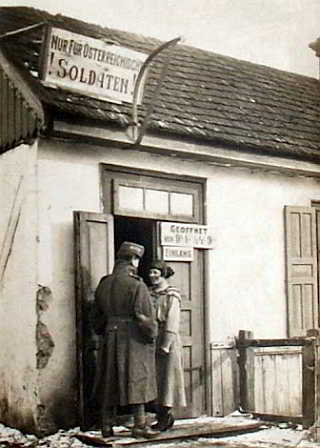
K.u.k. Mannschaftspuff, unkown where.

6.4.1983
Rosenhaus is mentioned as a house of ill repute where even ordinary soldiers cold enjoy themselves. It's green lights were visible from the abandoned photo pavillion in Brucker Lager.
Background
Rosenhaus was the author's name of a brothel in Bruck or Királyhida that has not been identified[a]. In 1915 there were five official brothels in the twin towns but none of them carried this name (Petzneck). There were also some unregistered brothels. Judging by the description in the novel it must be assumed that it was located near the river. Růžový dům may also be translated Das rosa Haus. One well known brothel was Das Blaue Haus, located at the end of the street Altstadt in Bruck an der Leitha[b].
Quote(s) from the novel
[II.3] Ti chodili do „Růžového domu“, jehož zelená světla byla též vidět od opuštěného fotografického ateliéru. Bylo to roztřídění jako později na frontě, kdy mocnářství nemohlo už svému vojsku ničím jiným pomoct než přenosnými bordely u štábů brigád, takzvanými „puffy“. Byly tedy k. k. Offizierspuff, k. k. Unteroffizierspuff a k. k. Mannschaftspuff.
Credit: Wolfgang Gruber, Friedrich Petzneck
Also written:Růžový důmHašekThe House of RosesParrottRosenhausReinerPink HouseSadlonRózsaházhu
Literature
- Die „Abenteuer des Braven Soldaten Schwejk” in Österreich, ,1983 [a]
- Kde to bylo, ,6.4.1983 [b]
| a | Die „Abenteuer des Braven Soldaten Schwejk” in Österreich | 1983 | |
| b | Kde to bylo | 6.4.1983 |
 | Hungarian Theatre |  | ||||
| ||||||
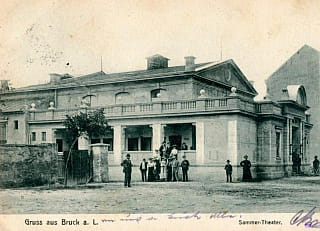
Raiffeisengürtel - Stadttheater
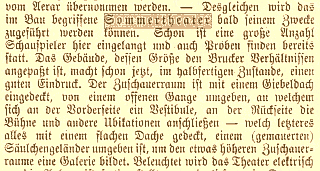
,12.6.1904

,4.4.1915
Hungarian Theatre was the theatre in Királyhida where Oberleutnant Lukáš got so enchanted by Etelka Kakonyi that he wrote the letter that set in motion the infamous Kakonyi affair. He was present at a squalid performance where officers from the artillery sat on the orchestra floor and observed the Jewish actresses (who were naked beneath their skirts) with artillery glasses. Otherwise it is revealed that the theatre had a gallery. In the letter itself Lukáš uses the term municipal theatre.
Background
Hungarian Theatre refers to a theatre that was supposed to be located in Királyhida but there is no trace of such an establishment in 1915. The only leisure institution in town was a cinema/provisional theatre. The nearest theatre was across the river in Bruck an der Leitha where there indeed existed a theatre, the so-called Sommertheater[a].
Mix-ups
Klara Köttner-Benigni concludes that the author mixes up institutions. There was a temporary theatre in Királyhida but this one doesn't fit the description in The Good Soldier Švejk. It is clear that the author had a permanent theatre building in mind, and in this context the one in Bruck is best fit. In the letter that Oberleutnant Lukáš wrote to Etelka Kakonyi he even uses the term Stadttheater (City Theatre). Köttner-Benigni also notes that Hašek didn't put much emphasis on locating buildings/institutions in Bruck or in Királyhida respectively[a].
Theatre in Bruck
Brucker Sommertheater was built in 1904 and performances started even before the construction had finished. The premiere took place on 16 June 1904 and the operette Die Fliedermaus by Johann Strauss the younger was performed in front of a sold-out theatre[b]. The theatre was supplied with electric power and also had a gallery. It was located in the current Raiffeisengürtel and associated with it was the restaurant of Josef Nowotny. The owner in 1911 was Eva Rappel who recently had aquired it. That same year she also bought Apollo-Theater in Bruck[d]. Newspaper articles reveal that the theatre also hosted cabarets.
Cinema in Királyhida
...
Quote(s) from the novel
[II.3] V jednom z důstojnických baráků v táboře čekal v noci Švejk na svého nadporučíka Lukáše, který šel večer do města do divadla a doposud se nevrátil.
[II.3] Nadporučík Lukáš neměl původně v úmyslu někde se zdržet. Šel kvečeru z tábora do města jen do maďarského divadla v Királyhidě, kde hráli nějakou maďarskou operetku s macatými židovkami-herečkami v předních úlohách, jejichž báječnou předností bylo to, že vyhazovaly při tanci nohy do výše a nenosily ani trikot, ani kalhoty a kvůli větší přitažlivosti pánů důstojníků holily se dole jako Tatarky, z čehož ovšem neměla žádný požitek galérie, a zato tím větší důstojníci od dělostřelectva sedící dole v parteru, kteří si na tu krásu brali s sebou do divadla dělostřelecké triedry.
[II.3] Milostivá paní!
Byl jsem včera přítomen v městském divadle hře, která Vás rozhořčila. Sledoval jsem Vás již při celém prvním jednáni, Vás i Vašeho pana manžela. Jak jsem pozoroval...
Credit: Klara Köttner-Benigni, Konrad Biricz
Also written:Maďarské divadloczUngarisches Theaterde
Literature
- Die „Abenteuer des Braven Soldaten Schwejk” in Österreich, ,1983 [a]
- Verschiedenes aus Bruck, ,12.6.1904
- Theater und Kunst, ,19.6.1904 [b]
- Ein neues Kinotheater in Bruck, ,17.8.1913 [c]
- Vom Brucker Sommertheater, ,11.6.1911 [d]
| a | Die „Abenteuer des Braven Soldaten Schwejk” in Österreich | 1983 | |
| b | Theater und Kunst | 19.6.1904 | |
| c | Ein neues Kinotheater in Bruck | 17.8.1913 | |
| d | Vom Brucker Sommertheater | 11.6.1911 |
 | Zum Erzherzog Albrecht |  | ||||
| ||||||

Deutsches Kaffehaus
, Wolfgang Gruber
Zum Erzherzog Albrecht is mentioned because Oberleutnant Lukáš dropped by after having visited the Hungarian Theatre in Királyhida where he had seen the enchanting Etelka Kakonyi. The author describes it as a large café and wine restaurant.
Background
Zum Erzherzog Albrecht was supposedly a large café and wine tavern in Bruck which was frequented by officers, but there are no historical traces of any café with this name. To judge by the author's description it may have been Deutsches Kaffehaus where only officers were allowed[a]. Another possibility is upmarket Hotel Erzherzog Franz Ferdinand.
Quote(s) from the novel
[II.3] Nadporučík Lukáš vzal si též z garderoby plášť a šel do města, kde setkal se ve velké vinárně a kavárně „U arcivévody Albrechta“ s několika důstojníky od 91. pluku.
Credit: Klara Köttner-Benigni, Friedrich Petzneck
Also written:The Archduke AlbrechtParrottAt the Archduke AlbertSadlonU arcivévody AlbrechtaczAlbrecht főherceghezhu
Literature
- Die „Abenteuer des Braven Soldaten Schwejk” in Österreich, ,1983 [a]
- Kde to bylo, ,6.4.1983
| a | Die „Abenteuer des Braven Soldaten Schwejk” in Österreich | 1983 |
 | Zum Kreuz des Heiligen Stephan |  | ||||
| ||||||
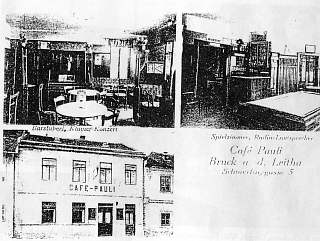
, Wolfgang Gruber
Zum Kreuz des Heiligen Stephan is mentioned as Oberleutnant Lukáš wrote the famous letter to Etelka Kakonyi here.
Background
Zum Kreuz des Heiligen Stephan was supposedly a small café cum brothel in Bruck or Királyhida, but even this one can not be historically traced. According to Klara Köttner-Benigni the brothels in Bruck were not associated with cafés[a], so this connection is most likely invented and re-located from somewhere else. Small cafés did exist though, one of them was Café Pauli which fits the description quite well.
Quote(s) from the novel
[II.3] Ve velice dobré náladě odešel do malé kavárny „U kříže sv. Štěpána“, kde zašel do malého chambre séparée, vyhnal odtamtud nějakou Rumunku, která se nabízela, že se svlékne do naha a že si s ní může dělat, co chce, poručil si inkoust, péro a dopisní papír, láhev koňaku a napsal po bedlivé úvaze toto psaní, které se mu zdálo být vůbec nejhezčím, které kdy napsal:
Also written:At the Cross of St StephenParrottAt the Cross of St. StevenSadlonU kříže sv. ŠtěpánaczSzent István keresztjéhezhu
Literature
| a | Die „Abenteuer des Braven Soldaten Schwejk” in Österreich | 1983 |
 | Die Steirer |  | ||||
| ||||||
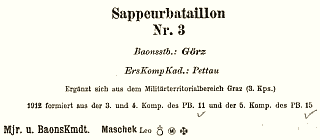
1914

Korpsbereich Nr. 3
1914
Die Steirer is mentioned by the author as a military unit that was garrisoned in Brucker lager. Sappeur Vodička was assigned to this unit.
Background
Die Steirer (The Styrians) is a term that usually refers to people from Styria but in this context it is obvious that the narrator has an army unit from this region in mind, most likely an engineering battalion (Sappeure or Pioniere).
Sapper battalions
In k.u.k. Heer the pure engineering troop units were the so-called Zákopníci who until 1912 had counted 15 battalions. In 1912 these were reorganised into 8 Pionierbataillone and 14 Sappeurbataillone. As a rule a sapper battalion was recruited from one of the 16 army corps districts. Thus Sappeurbataillon Nr. 3 was recruited from Korpsbereich Nr. 3 (Graz), an area that apart from Styria also included the areas westwards towards the Adtriatic Ocean and the border with Italy. So if any sapper-unit was to be classed as "Styrians" it would be this one. Their command of the Ergänzungsbezirk was located in Pettau (now Ptuj) and the battalion command in Görz (now Gorizia/Gorica). Commander in 1914 was Major Leo Maschek[a].
Styrians in Brucker Lager
Attempts to establish which Styrian units were present in Brucker Lager in 1915 have so far failed. It is not known if other replacement units than Infanterieregiment Nr. 91 were located here. Moreover, many units may have passed through the camp for training purposes.
Infanteriavdelingar
Infanteriregiment hadde òg sine eigne ingeniørsoldatar så Vodička kan i teorien ha vore tildelt eitt av desse. Tree infanteriregiment i k.u.k. Heer var rekrutterte frå Styria: Infanterieregiment Nr. 27 (Graz), Infanterieregiment Nr. 47 (Marburg) og Infanterieregiment Nr. 87 (Cilli). I tilleg stitle området soldatar til det lette infanteriet, her Feldjägerbataillon Nr. 9 (Graz) og delvis nokre andre. I tillegg vart k.k. Landwehrinfanterieregiment Nr. 3 (Graz) og k.k. Landwehrinfanterieregiment Nr. 26 (Marburg) rekrutterte frå Steiermark.
Infantry units
All infantry regiments kept their own engineering soldiers so Vodička could also in theory have been assigned to one of these. Three infantry regiments in k.u.k. Heer were recruited from Styria: Infanterieregiment Nr. 27 (Graz), Infanterieregiment Nr. 47 (Marburg) and Infanterieregiment Nr. 87 (Cilli). In addition the area provided manpower for the light infantry: Feldjägerbataillon Nr. 9 (Graz) and partly others. In addition k.k. Landwehrinfanterieregiment Nr. 3 (Graz) and k.k. Landwehrinfanterieregiment Nr. 26 (Marburg) were recruited from Styria.
Quote(s) from the novel
[II.3] Nadporučík zabalil se opět do deky, ze které ho Švejk vytáhl, a spal dál, zatímco Švejk putoval dál do Királyhidy. Najít Sopronyi utczu čís. 16 nebylo by bývalo tak těžké, kdyby ho náhodou nebyl potkal starý sapér Vodička, který byl přidělen k „štajerákům“, jejichž kasárna byla dole v lágru.
Also written:The StyriansenSteierbuamReinerŠtajerácicz
Literature
- Schematismus für das k.u.k. Heer (s. 1580), ,1914 [a]
| a | Schematismus für das k.u.k. Heer (s. 1580) | 1914 |
 | Zum schwarzen Lamm |  | ||||
| ||||||

, Wolfgang Gruber
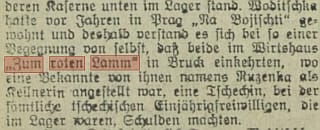
Grete Reiner mixing the colours
,1.3.1927
Zum schwarzen Lamm was the pub where Švejk and Sappeur Vodička refreshed themselves before going to Soproni utca to deliver the infamous letter from Oberleutnant Lukáš to Etelka Kakonyi. Here served the well-known Czech waitress Růženka who was owed money by all the Czech one-year volunteers that had been in Brucker Lager.
Background
Zum schwarzen Lamm was supposedly a pub in Bruck, but there are no historical traces of it. The name may be a corruption of Zum schwarzen Adler, a café located in Altstadt. During World War I this street functioned as the entertainment district of Bruck.
Swapped colours?
A strange detail appears in Grete Reiner's German translation. She calls it Zum roten Lamm, a place that according to Gerhard Tötschinger may have existed. His source was however some unnamed teacher. If it against all probability existed, it would have been located in Raiffeisengürtel 7 at the end of Altstadt[a]. Has Jaroslav Hašek been "corrected", and in that case why? Reiner was not very solid in Czech but to make a basic error like mixing red and black (červený and černý) seems unlikely.
No lamb in sight
Red Lamb was in any case a rare and unlogigal name for a tavern. Unsurprising, a search in ÖNB (term "Zum roten Lamm") yields only 1 hit, whereas "Zum schwarzen Lamm" has 189, a more plausible number. Still, at the end of the day no "Lamm", whatever colour or shape, is known to have ever existed in Bruck or Királyhida.
Quote(s) from the novel
[II.3] Nadporučík zabalil se opět do deky, ze které ho Švejk vytáhl, a spal dál, zatímco Švejk putoval dál do Királyhidy. Najít Sopronyi utczu čís. 16 nebylo by bývalo tak těžké, kdyby ho náhodou nebyl potkal starý sapér Vodička, který byl přidělen k „štajerákům“, jejichž kasárna byla dole v lágru. Vodička bydlíval před léty v Praze na Bojišti, a proto při takovém setkání nezbylo nic jiného, než že oba zašli do hospody „U černého beránka“ v Brucku, kde byla známá číšnice Růženka, Češka, které byli všichni čeští jednoročáci, kteří kdy byli v lágru, nějaký obnos dlužni.
Credit: Klara Köttner-Benigni, Konrad Biricz
Also written:The Black LambParrottZum Roten LammReinerAt the black Ram/The Little black RamSadlonU černého beránkaczFekete báránythu
Literature
- Die „Abenteuer des Braven Soldaten Schwejk” in Österreich, ,1983 [a]
- Kde to bylo, ,6.4.1983
| a | Die „Abenteuer des Braven Soldaten Schwejk” in Österreich | 1983 |
 | K.k. Landwehrinfanterieregiment Nr. 16 |  | ||||
| Krowodrza, Wrocławska 82 | ||||||
| ||||||

Landwehr-Ergänzungsbezirk Nr. 16
1913

The barracks of LIR. Nr. 16, Krowodrza
K.k. Landwehrinfanterieregiment Nr. 16 is mentioned by Sappeur Vodička when he tells Švejk about a brawl he had been involved in by Pausdorf. He was about to attack Landwehrsoldat Purkrábek because he though the latter was a Hungarian. Purkrábek then exclaims: "Tonda, come on, it's me, Purkrábek, from 16. landwehr!"
Background
K.k. Landwehrinfanterieregiment Nr. 16 was one of 37 k.k. Landwehr infantry regiments and like most of its peer units it was established in 1889. The regiment was recruited from the districts Kraków and Wadowice. Their barracks were located in Krowodrza, now a district in Kraków. In 1914 staff and all three battalions were garrisoned in Kraków. Their commander was Oberst Heinrich von Dürfeld[a]. At the start of the war they were reporting to 46. Landwehrdivision. The regiment was predominantly manned by Poles, more than 80 per cent.
During the war
The regiment was part of the invasion of Russian Poland in August 1914 and participated in the battle of Kraśnik at the end of the month. During the fighting, colonel Dürfeld and several staff officers were wounded[b]. On 25 October 1914 they took part in the battle of Ivangorod (now Dęblin)[c] and later that year and until April 1915 they stayed near the river Nidą. In May they participated in the Central Powers' breakthrough by Gorlice-Tarnów. After this battle and during the summer they pursued the enemy to Volhynia and reached the area by Lutsk in early September[d].
From 30 November 1915, they were in reserve between Dubno and Chorupan, the area where 9. Infanteriedivision with Infanterieregiment Nr. 91 had been fighting in September and where Jaroslav Hašek was taken prisoner. In June 1916 the regiment suffered disastrous losses during the first day of the Brusilov offensive by Sapanow. In August they were transferred to the Romanian front and during the spring and summer of 1918 they were taking part in the occupation of Ukraine. In August 1918 they were transported to the Italian front[d].
Quote(s) from the novel
[II.3] „Jednou ti už takovýho kluka maďarskýho držím za chřtán v Pausdorfě, kam jsme šli my saperáci na víno, a chci mu dát jednu überšvunkem přes kokos v tý tmě, poněvadž jsme hned, jak to začlo, praštili láhví do visací lampy, a von najednou začne křičet: ,Tondo, dyť to jsem já, Purkrábek, vod 16. landwehr!’
Credit: Wacław Szczepanik, Österreich-Ungarns letzter Krieg, Jaroslav Šerák
Literature
- Schematismus der k.k. Landwehr (s. 253), ,1914 [a]
- Auf dem Schlachtfeld zum Major befördert, ,5.9.1914 [b]
- Auf dem Felde der Ehre gefallen, ,16.5.1915 [c]
- Między armią austro-węgierską a Wojskiem Polskim, ,2018 [d]
| a | Schematismus der k.k. Landwehr (s. 253) | 1914 | |
| b | Auf dem Schlachtfeld zum Major befördert | 5.9.1914 | |
| c | Auf dem Felde der Ehre gefallen | 16.5.1915 | |
| d | Między armią austro-węgierską a Wojskiem Polskim | 2018 |
 | Ein stilles Lokal |  | |||
| |||||
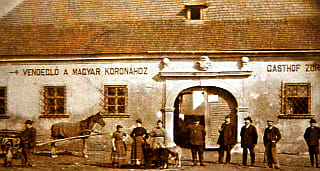
Gasthof zur Ungarische Krone before the First World War.
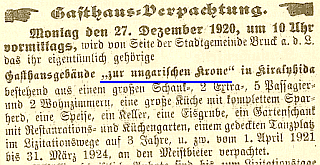
,26.12.1920
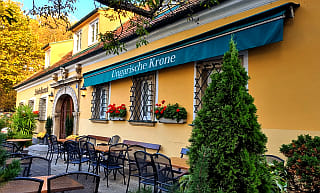
Ungarische Krone, 14.10.2023
Ein stilles Lokal is described by Sappeur Vodička when tells Švejk about "an inn between the gardens by the river, quiet as a chapel, made for causing trouble". He doesn't name the place, but goes into some details about how he provoked a fight there. Needless to say, the recipients of his wrath were Hungarians.
Background
The quiet pub by the river was very likely Gasthof zur Ungarische Krone in Királyhida, a restaurant that is still operating (2023). Sappeur Vodička's description fits perfectly: the establishment is located by the Leitha between the gardes and provides a quite atmosphere, a situation that probaly wasn't much different in 1915.
Steeped in history
The restaurant is one of the oldest in the entire area and the building itself dates back 300 years. It was originally a monastery that was destroyed during an Ottoman incursion. In 1726 it was rebuilt and functioned thereafter as hostel, mail station and eventually a roadside inn[a]. The municipality owned the property but already before World War I it was leased to private landlords. During a round of lease auctions in 1920 it is revealed that the property had a restaurant with a garden and also five guest-rooms[d].
According to Cilla Krakhofer (who owned it in 1983) fighting between soldiers definitely took place during World War I. Eventually it was leased to the Krakhofer family who in the end purchased it[b].
It is still owned by the family (Maria Krakhofer) and functions as hotel and restaurant. When the ownership transition happened is not known but as late as 1935 the municipality still owned the place[c].
Klara Köttner-Benigni
Wahrscheinlich meint Hašek mit dem stille Gasthaus, das am Fluß bei Gäne steht, die „Ungarische Krone”. Sie wurde 1726 auf Weisung Karls V als Herberge errichtet und diente später als Einkehrgasthof. Sein Eigentümer war die Stadtgemeinde Bruck an der Leitha. Er wurde späters verpachtet und schließlich an die Familie Krakhofer verkauft. Neben dem etwas abgesetzt von die Straße liegenden Restaurant un mittelbar an der Leitha erstrecht sich noch jetzt ein Park mit alte Bäumen. Andere Lokale in Flußnähe bestanden nur vorübergehen. In der „Ungarischen Krone” sind Raufereien zwischen Soldaten während des Ersten Weltkriege verbürgt, wie die heutige Besitzerin Cilli Krakhofer berichtet.
Quote(s) from the novel
[II.3] Člověk míní, ale pánbůh mění. Tam u řeky až mezi zahradami našel jsem vopravdu takovej lokál, tichej jako kaple, jako stvořenej pro kravál.
Credit: Klara Köttner-Benigni, Konrad Biricz
Literature
- "Ungarische Krone", ,2020 [a]
- Die „Abenteuer des Braven Soldaten Schwejk” in Österreich, ,1983 [b]
- Bruck a. d. L., ,24.3.1935 [c]
- Aus der am 25. Oktober i. J. abgehaltenen Gemeinde-Ausschußsitzung, ,22.12.1912
- Gestorben, ,28.9.1913
- Gartenfest, ,4.8.1918
- Gasthausverpachtung, ,26.12.1920 [d]
| a | "Ungarische Krone" | 2020 | |
| b | Die „Abenteuer des Braven Soldaten Schwejk” in Österreich | 1983 | |
| c | Bruck a. d. L. | 24.3.1935 | |
| d | Gasthausverpachtung | 26.12.1920 |
 | Invalidovna |  | |||
| Karlín/24, Královská tř. | |||||
| |||||
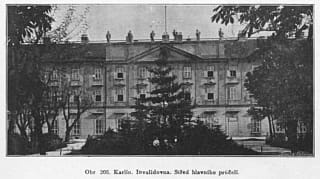
,1901

,1900
Invalidovna appears in the story Švejk tells Sappeur Vodička about liquor trader Paroubek who chased a Slovak across Karlín and Žižkov, all the way to Malešice.
Background
Invalidovna is a former institution for war invalids and veterans in Karlín, built from 1731-1737. Its model was Les Invalides, a building for veterans inaugurated in Paris in 1679. The building was seriously damaged by the floods in August 2002. Until 2013 it was partially used by VÚA. During World War I it was used as a lasaret.
Quote(s) from the novel
[II.3] Potom ještě řekl Paroubkovi, že je huncút a šaščínská bestie, tak ho milej Paroubek chyt, votlouk mu jeho pastě na myši a dráty vo hlavu a vyhodil ho ven a mlátil ho po ulici tyčí na stahování rolety až dolů na Invalidovnu a hnal ho, jak byl zdivočelej, přes Invalidovnu v Karlíně až nahoru na Žižkov, vodtud přes Židovský pece do Malešic, kde vo něj konečně tyč přerazil, takže se moh vrátit nazpátek do Libně.
Literature
 | Na Růžovém ostrově |  | ||||
| Zaběhlice/59, - | ||||||
| ||||||
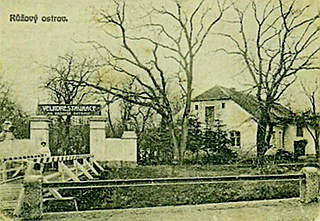
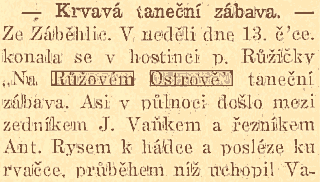
,26.7.1909
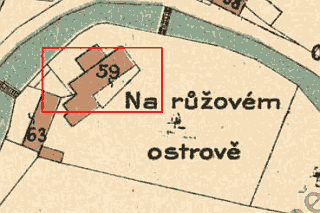
Na Růžovém ostrově in Záběhlice was yet another place where Sappeur Vodička had been involved in fighting, the noise could be heard all the way to Michle.
Background
Na Růžovém ostrově was a large restaurant with a garden, owned by Václav Růžička, located in Záběhlice on an artificial island in the Botič stream called Růžový ostrov (Rose Island).
The restaurant was in business from at least 1880[a] and was in 1883 owned by some Almer[b]. By 1886 Růžička had been taken over[c] and he probably managed it until he died on 21 February 1924. He was buried at the cemetry in Zaběhlice[d]. After Růžička's death the restaurant was managed by his daughter Růžena Burgetová[e].
Rose Island was a popular excursion destination, and arranged dancing, meetings, and other gatherings. It was operating until 1928 but since then the building has been used for other purposes.
Quote(s) from the novel
[II.3] „Plácnu taky ženskou, Švejku, mně je to jedno, to ještě neznáš starýho Vodičku. Jednou v Záběhlicích na ,Růžovým ostrově’ nechtěla se mnou jít jedna taková maškara tančit, že prej mám voteklou hubu. Měl jsem pravda hubu vopuchlou, poněvadž jsem právě přišel z jedný taneční zábavy v Hostivaři, ale považ si tu urážku vod tý běhny. ,Tak tu máte taky jednu, velectěná slečno,’ řek jsem, ,aby vám to nebylo líto.’ Jak jsem jí tu jednu utrh, povalila celej stůl na zahradě i se sklenicema, za kterým seděla s tatínkem a s maminkou a s dvěma bratry. Ale nebál jsem se celýho ,Růžovýho ostrova’.
Credit: Jaroslav Šerák, Česká televize
Also written:Roseninselde
Literature
- Románové restaurační a jiné zábavní podniky, ,2009 - 2021 [e]
- Ze Záběhlic, ,26.8.1880 [a]
- Krádeže, ,9.2.1883 [b]
- Hospodářský spolek okresu Král. Vinohradského, ,5.5.1886 [c]
- Úmrti, ,23.2.1924 [d]
- Letní seriál o pražských ostrovech,
| a | Ze Záběhlic | 26.8.1880 | |
| b | Krádeže | 9.2.1883 | |
| c | Hospodářský spolek okresu Král. Vinohradského | 5.5.1886 | |
| d | Úmrti | 23.2.1924 | |
| e | Románové restaurační a jiné zábavní podniky | 2009 - 2021 |
 | Hauptwache |  | ||||
| Királyhida, Lagerstrasse | ||||||
| ||||||


,1913
Hauptwache is mentioned because Švejk and Sappeur Vodička were led to the prison here after the fight in Soproni utca. It is also the place where Einjährigfreiwilliger Marek re-enters the story for the first time since the troop transport had a break at a railway station in Vienna. He had refused to clean the latrines and been locked up. The greater part of the action in [II.4] takes place here.
Background
Hauptwache (Main guard-house) was the main guard building and command centre in Brucker Lager in Királyhida. This was also where the camp prison was located. Some time after 1955 the building was demolished[a]. There was also a guard in the so-called Neues Lager but this was merely referred to as Wachhaus. It has not been possible to verify that it has prison cells here. Soldiers from Infanterieregiment Nr. 91 were garrisoned in Altes Lager (old camp) so this is surely where the action in The Good Soldier Švejk took place[b]. The main guard house in the old camp was located halfway down Lagerallee.
Klara Köttner-Benigni
Die Hauptwache war das Zentrum des „Brucker Lagers”. Hier wurden die Wachen vergattert und in ihre Lagerbereiche abkommandiert, um für Ordnung und Disziplin zu sorgen. So liefen hier auch alle Nachrichten und Meldungen zusammen. In der Hauptwache waren auch die Arreste untergebracht. Die wechselnden Regimentsmusikkapellen konzertierten vor der Hauptwache. Nach 1921 wurde das Objekt umgebaut und als Offizierscasino und Lagerkaffeehaus verwendet. Die Bevölkerung nannte es "Milchmariandl”. 1955 fand in dem Objekt das Bankett aus Anlaß der Übergabe des „Brucker Lagers” durch die sowjetische Besatzungsmacht an die österreichischen Behörden statt. Anschließend wurde es nicht mehr verwendet und bedauerlicherweise abgerissen.
Quote(s) from the novel
[II.3] Starý sapér Vodička po celou cestu tvrdošíjně mlčel. Až teprve když vcházeli na hauptvachu, řekl zasmušile k Švejkovi: „Nepovídal jsem ti to, že Maďary neznáš?“
[II.3] Je s ním nějaký sapér Vodička, u kterého po rvačce našli, když je přivedli na hauptvachu, váš dopis, který jste poslal paní Kákonyiové.
[II.4] "Nechtěl jsem pucovat hajzly na hauptvaše," odpověděl, "tak mě vedli až k obrštovi. A to je pěkná svině..."
Also written:Main guard-houseenHauptvacha/HauptwachaHašekHovudvaktannHlavní stražnicecz
Literature
- Die „Abenteuer des Braven Soldaten Schwejk” in Österreich, ,1983 [a]
- Z mých válečných pamětí, ,2021 [b]
| a | Die „Abenteuer des Braven Soldaten Schwejk” in Österreich | 1983 | |
| b | Z mých válečných pamětí | 2021 |



|
II. At the front |
 | |
3. Švejk's happenings in Királyhida | |||
| © 2008 - 2024 Jomar Hønsi | Last updated: 20.11.2024 |


